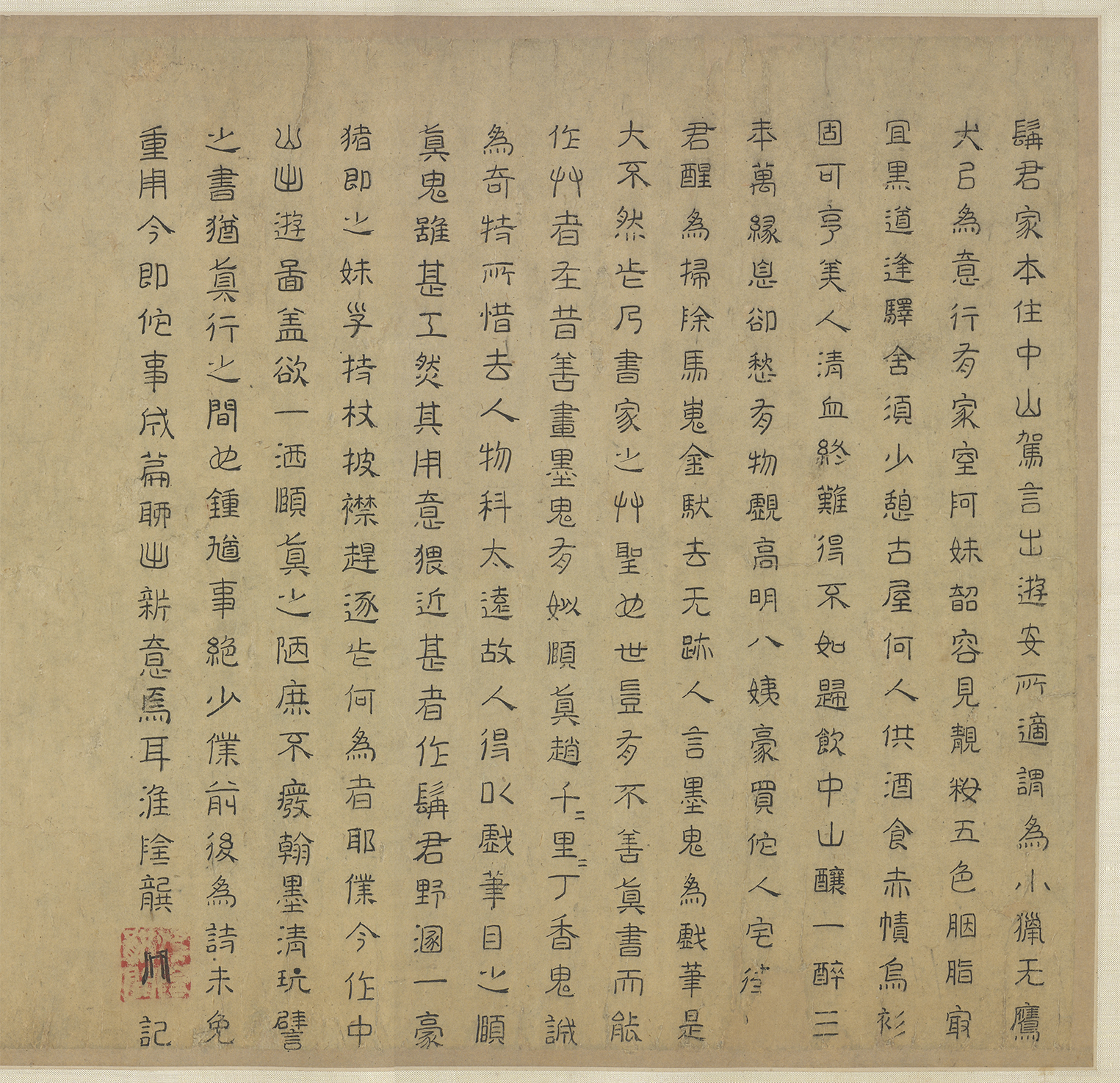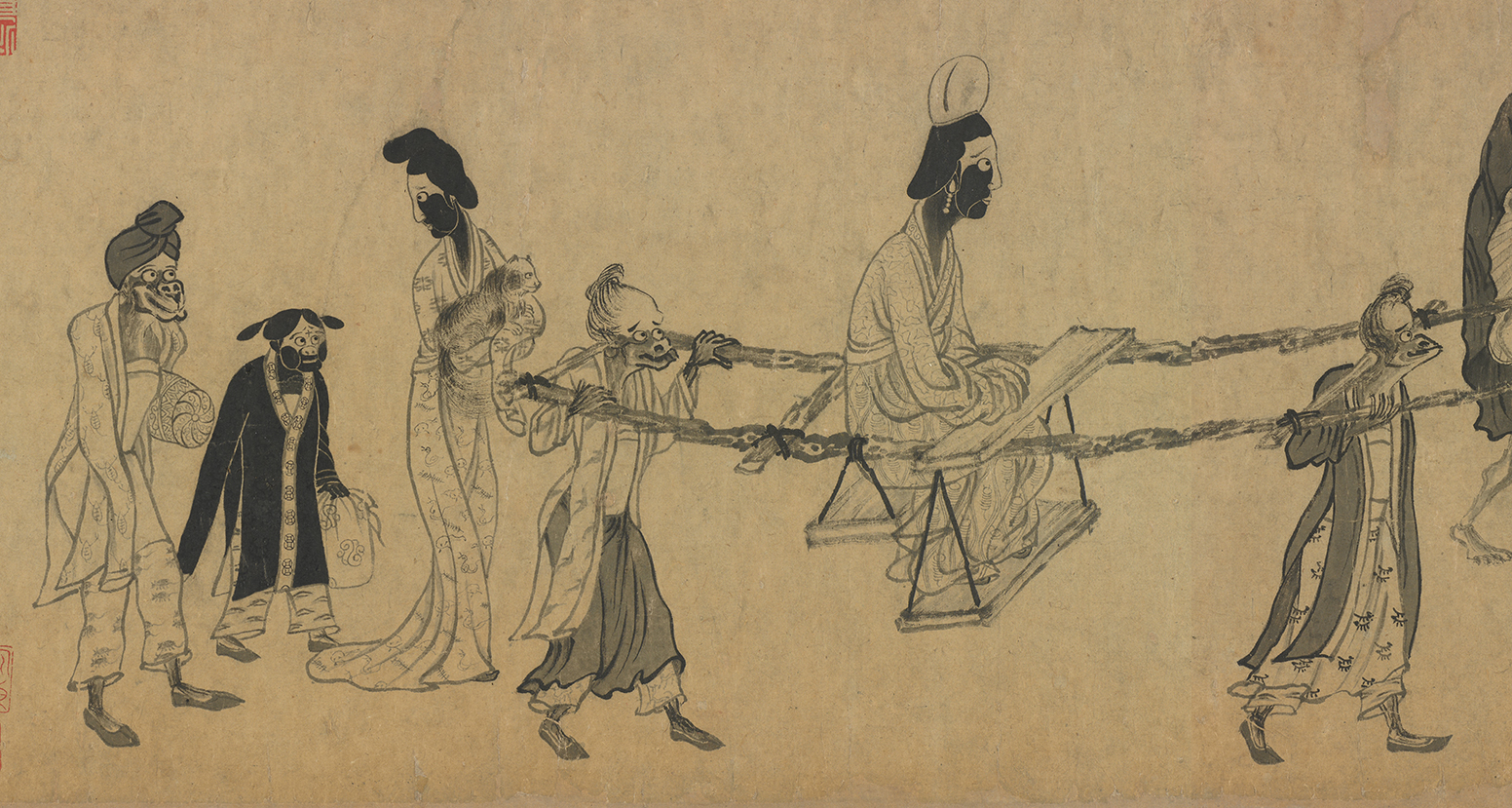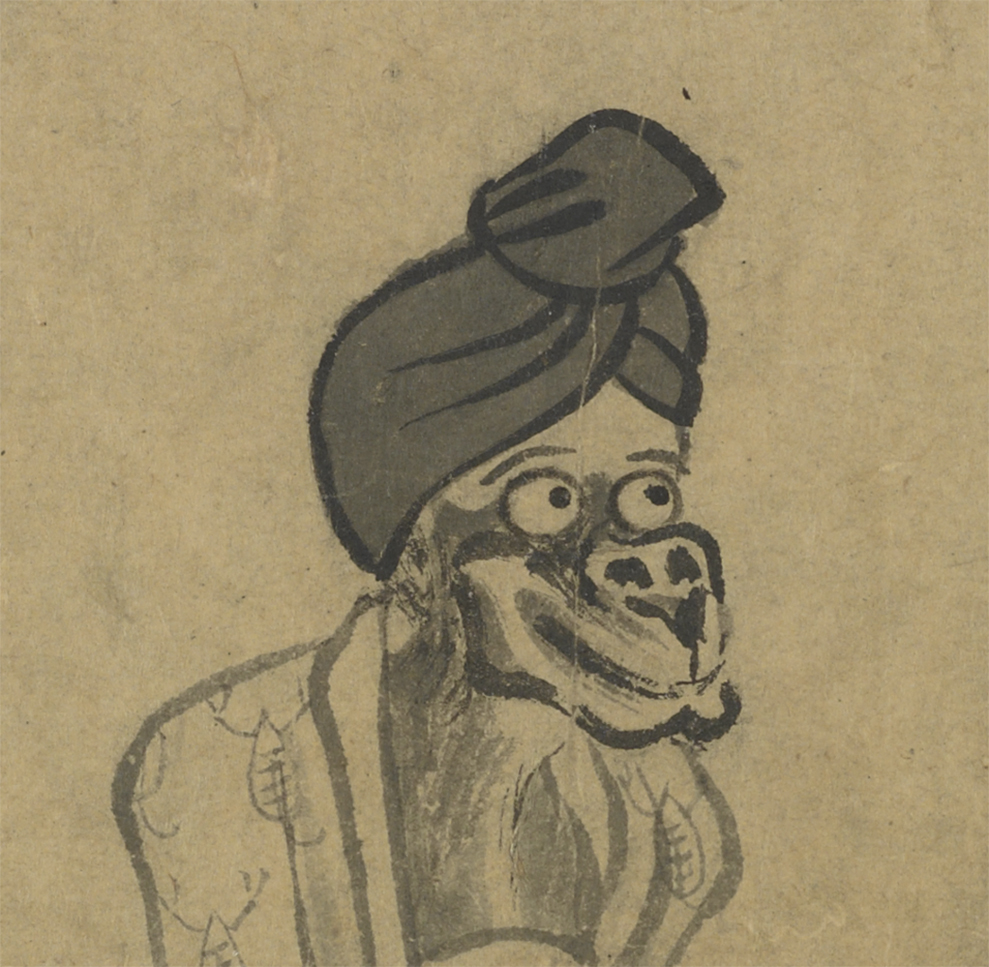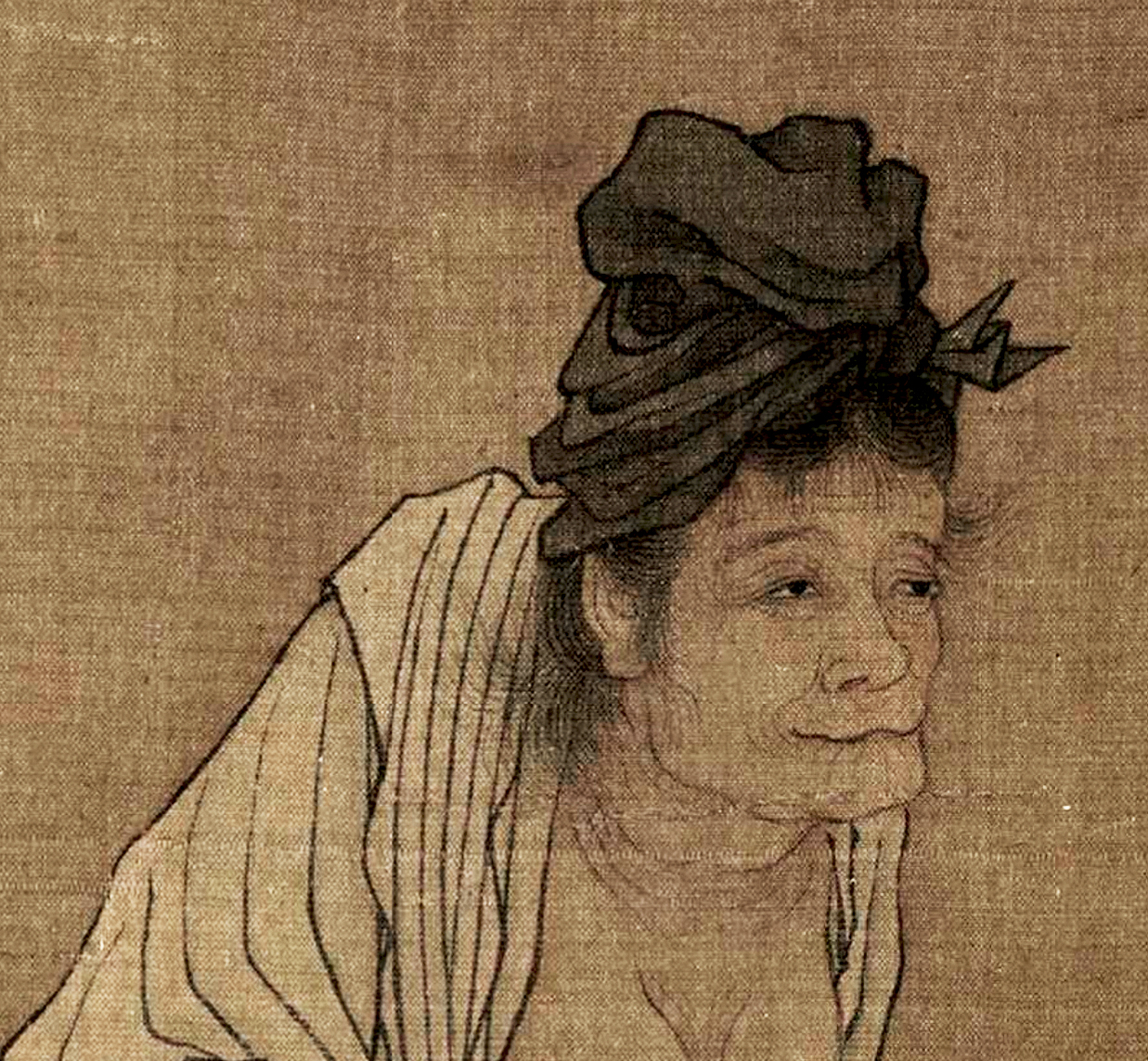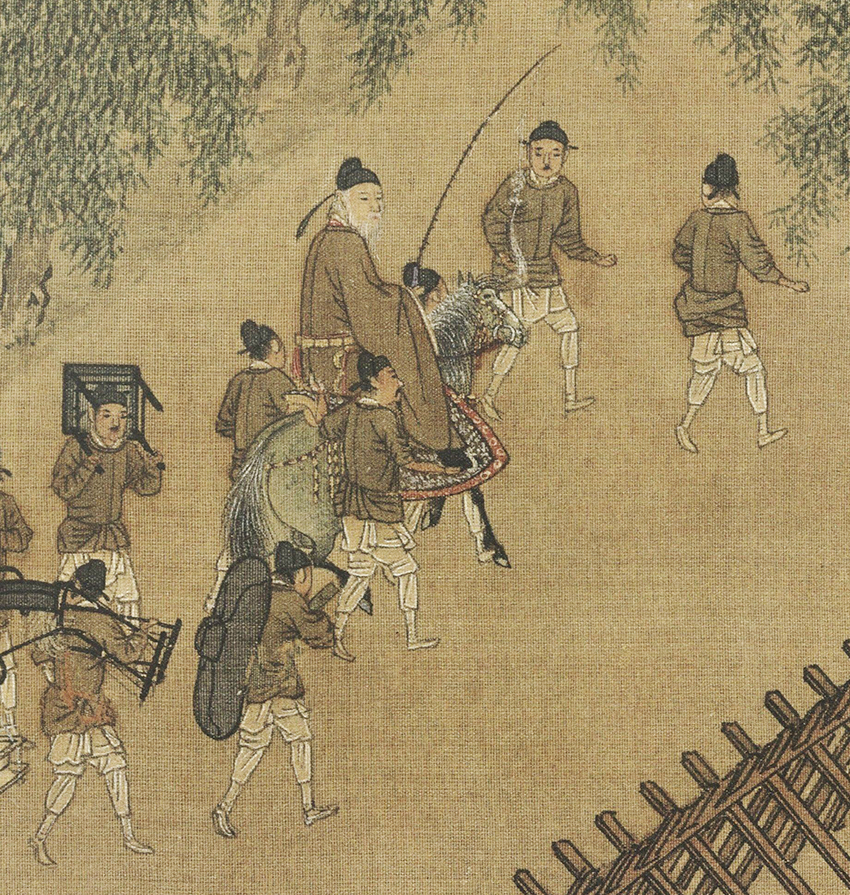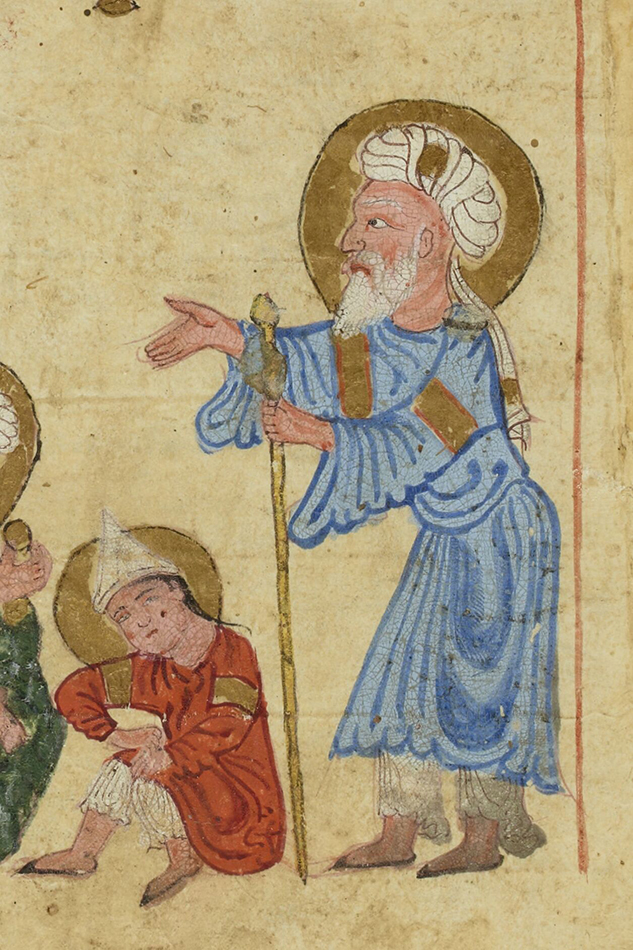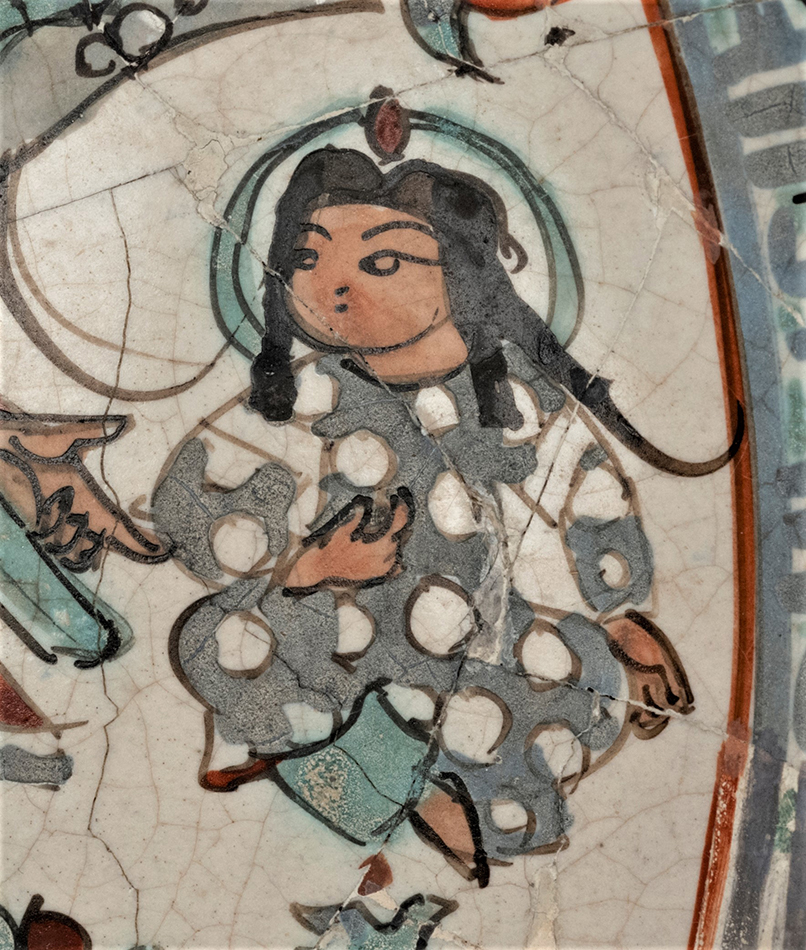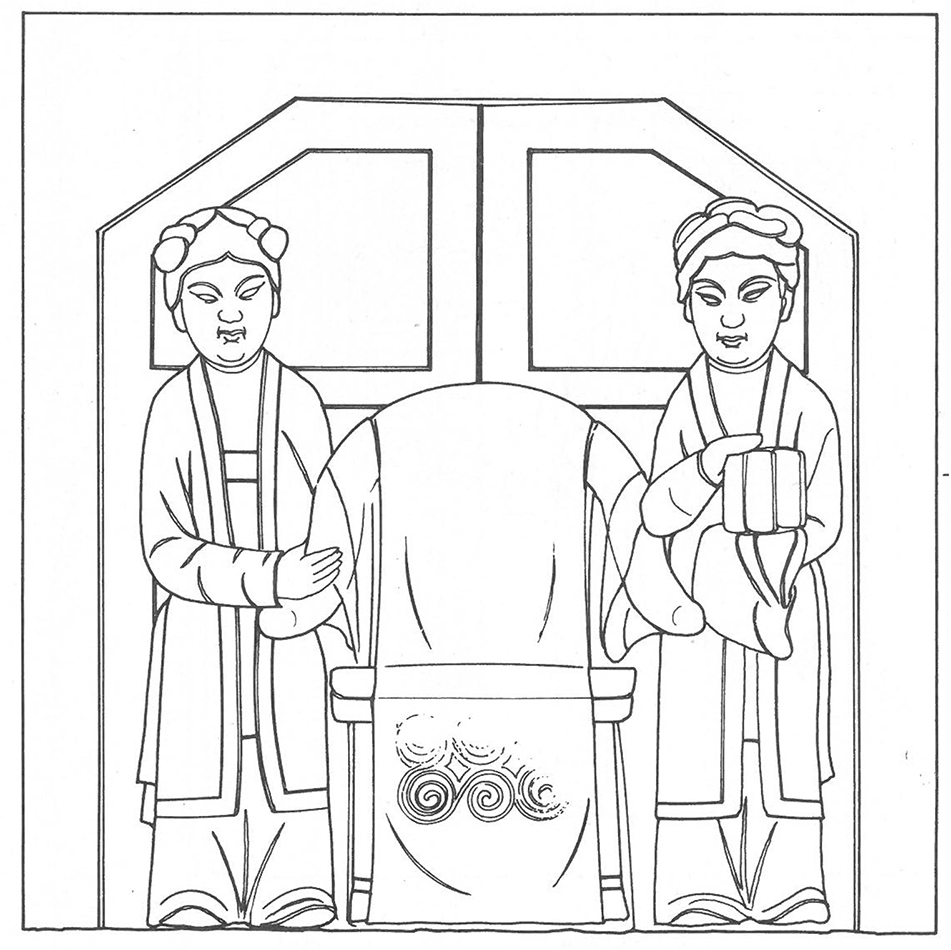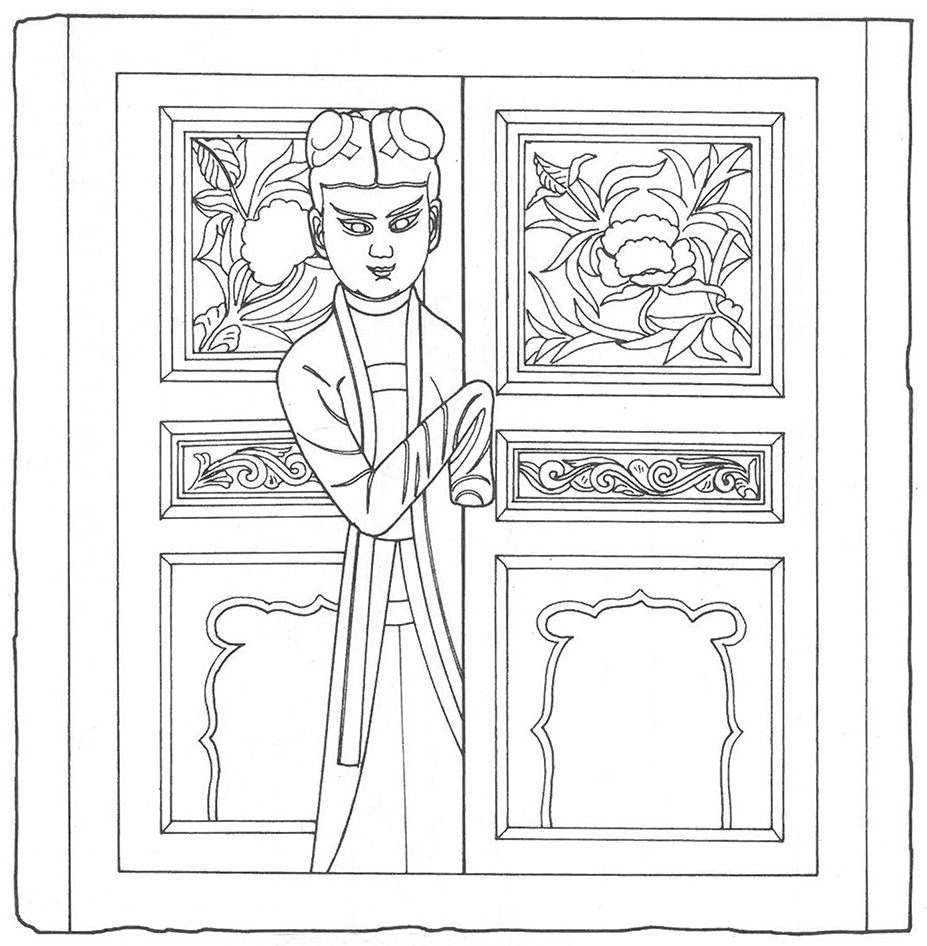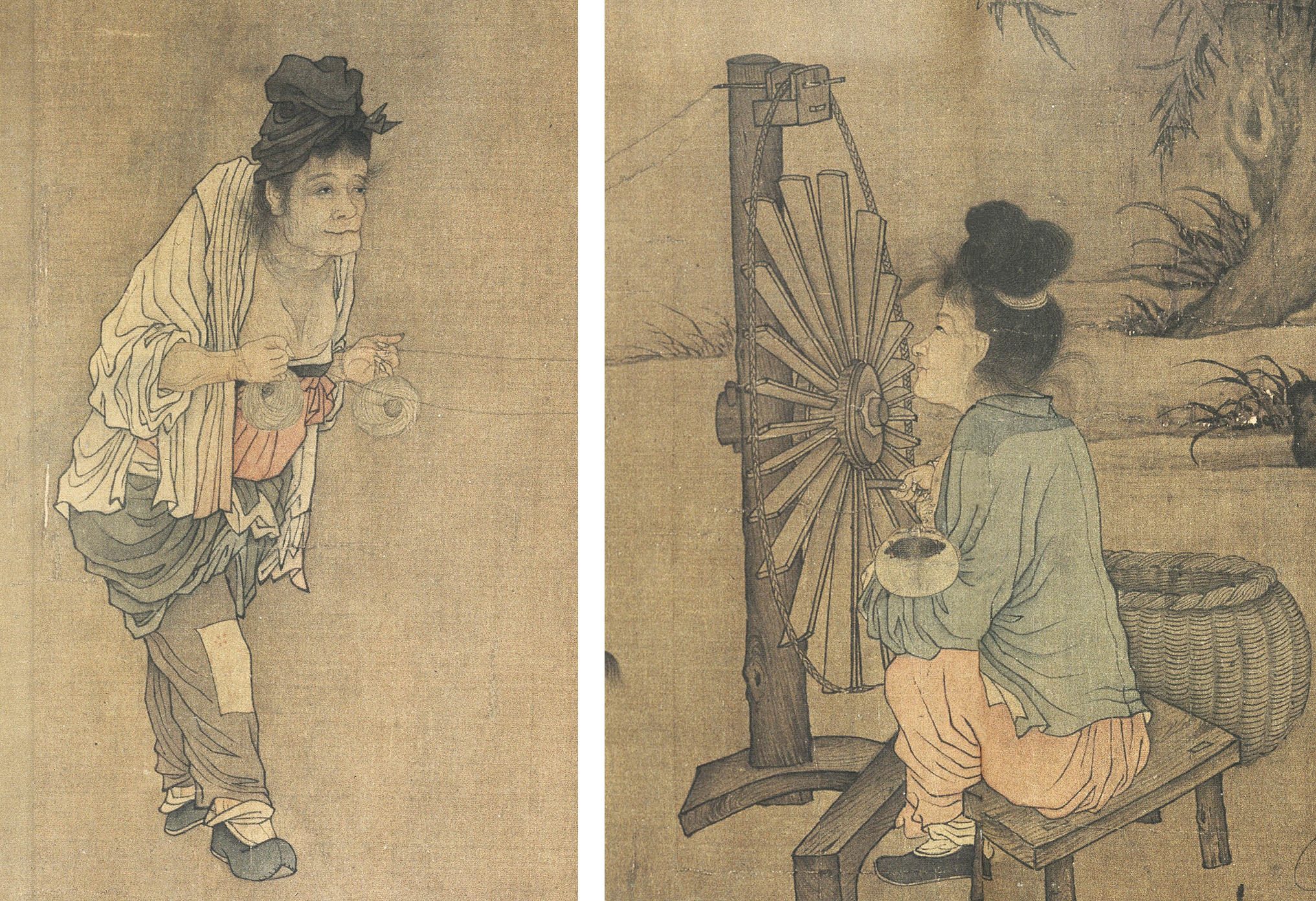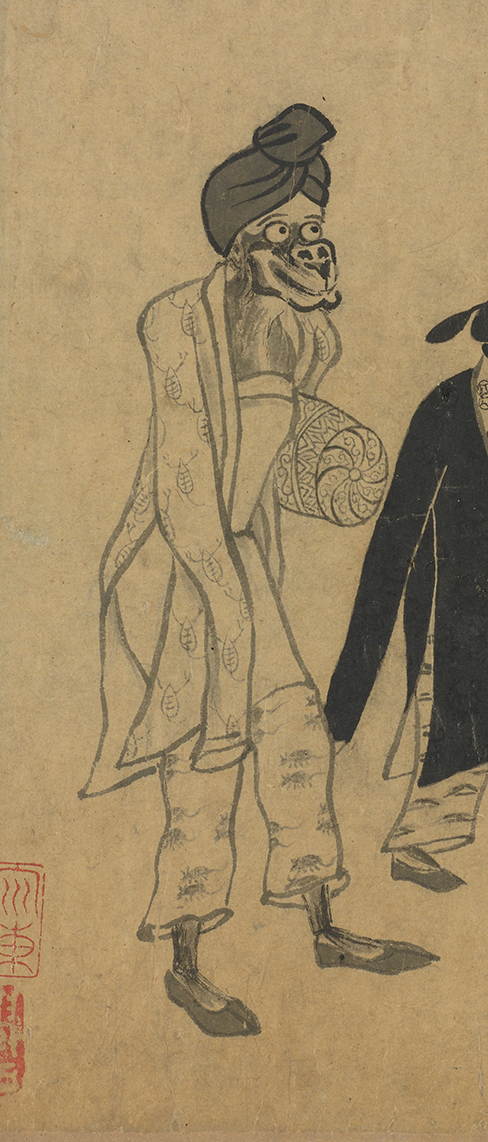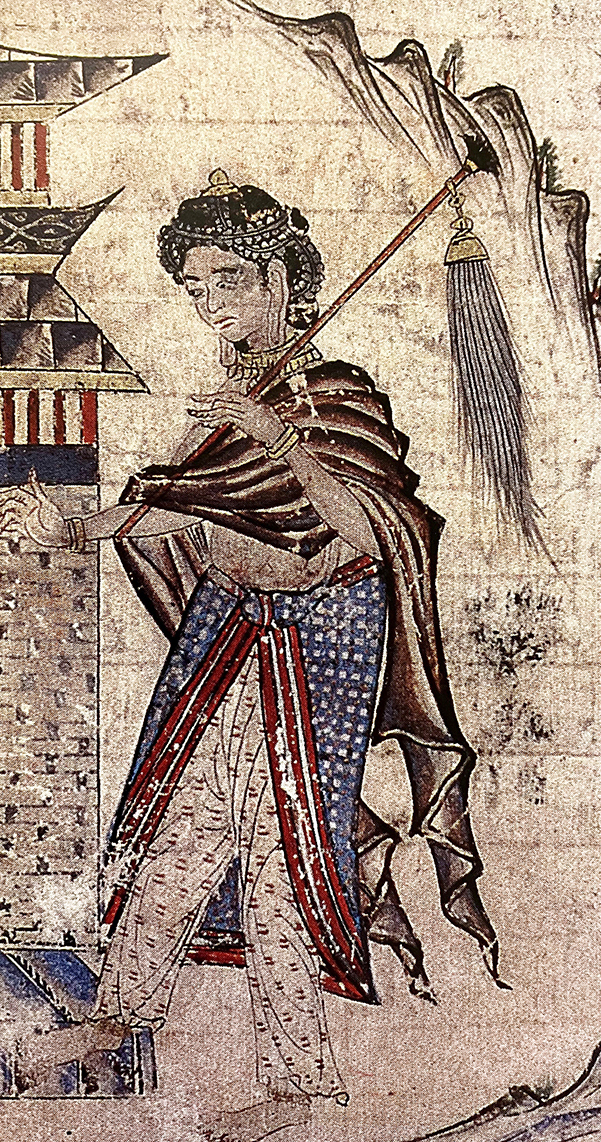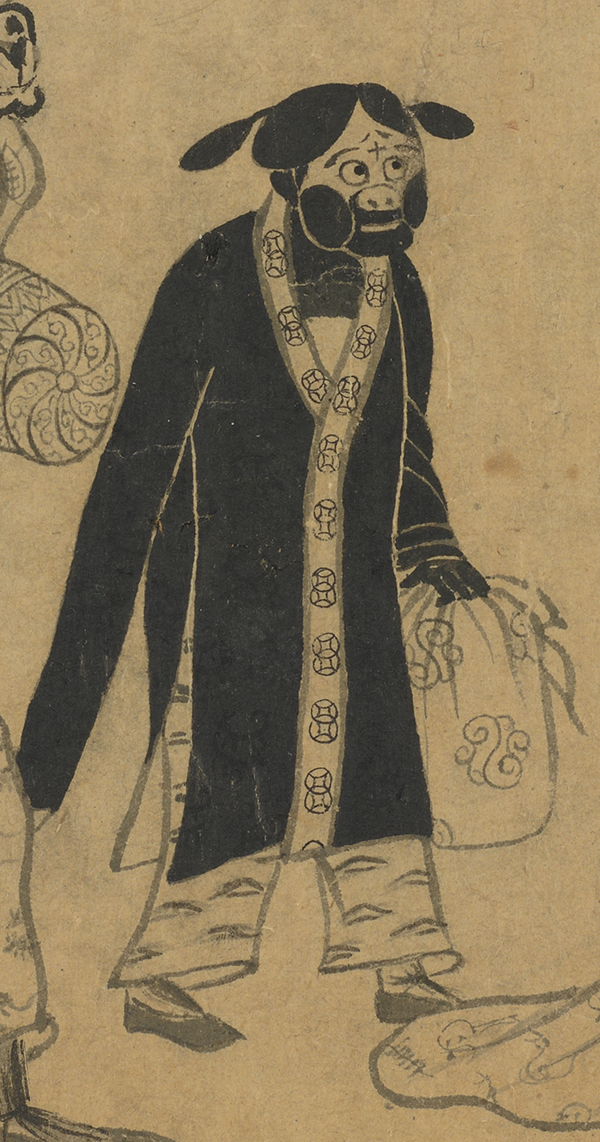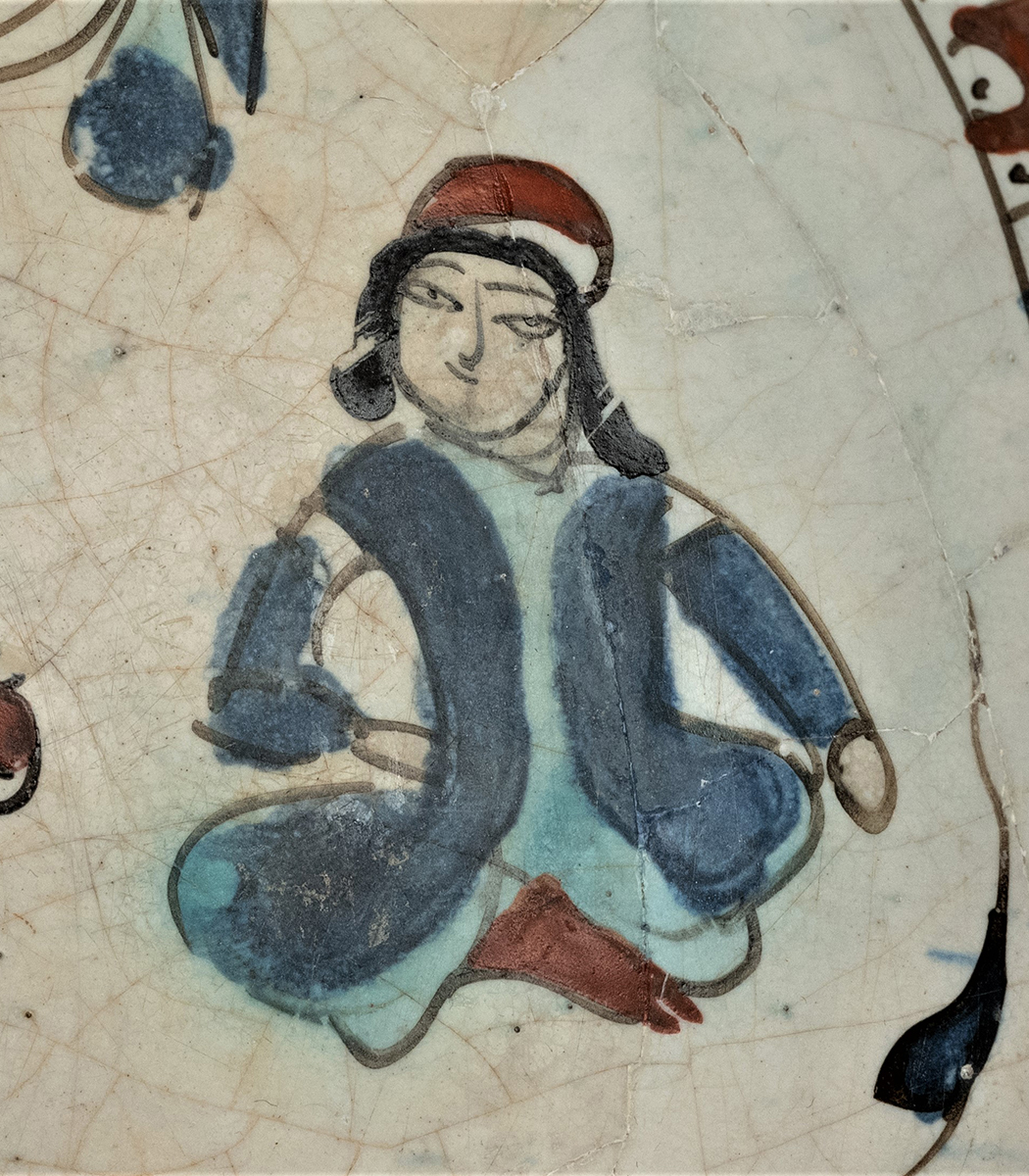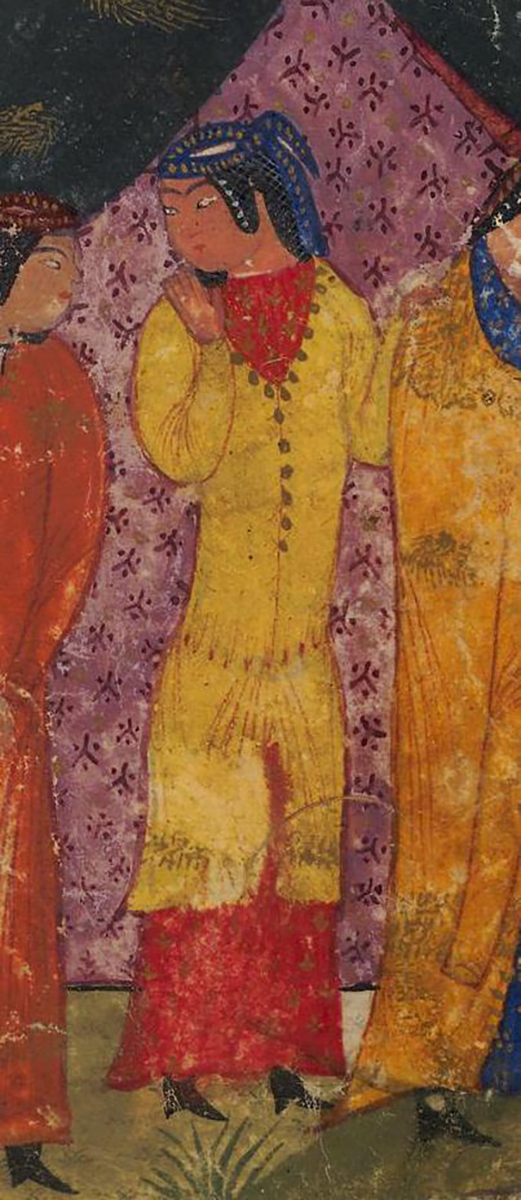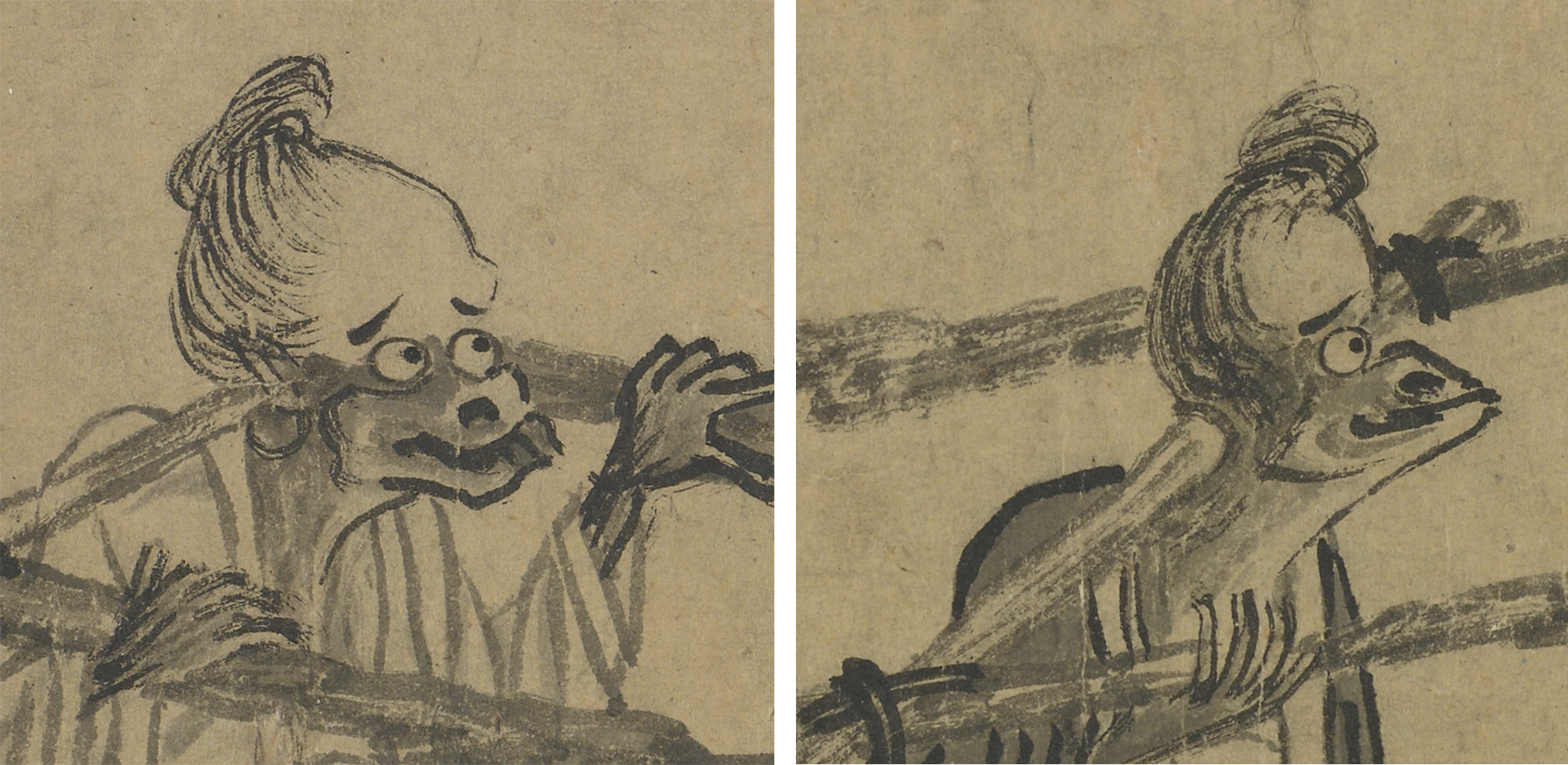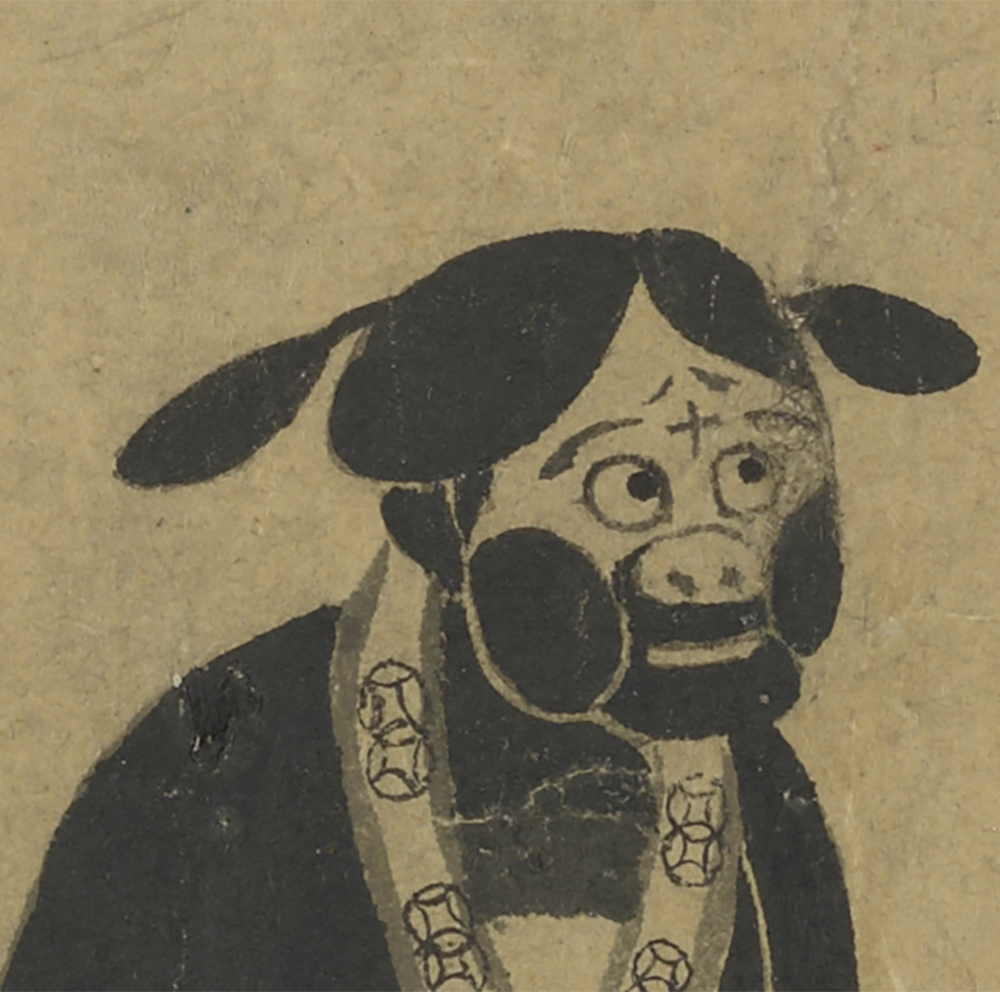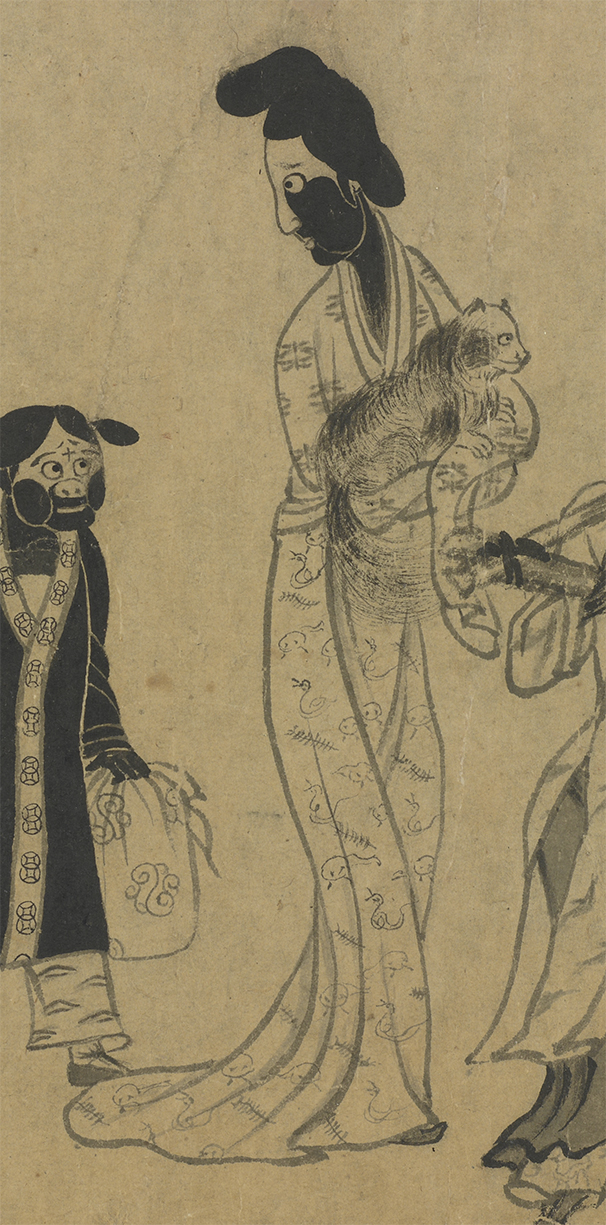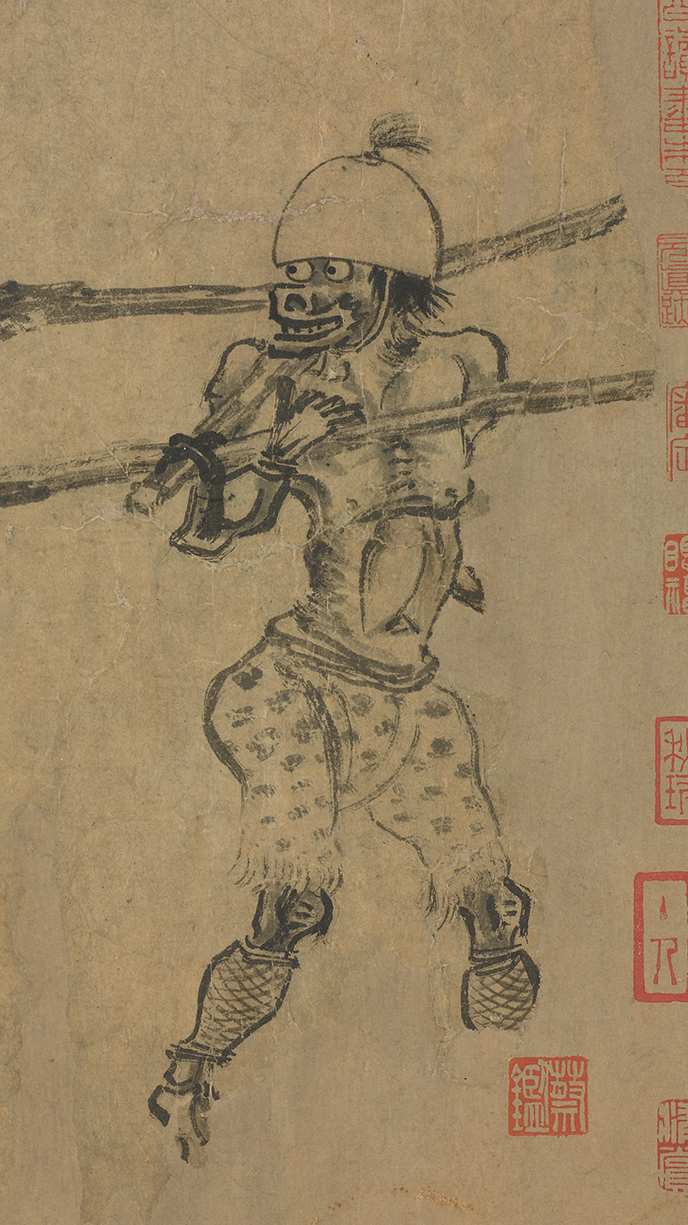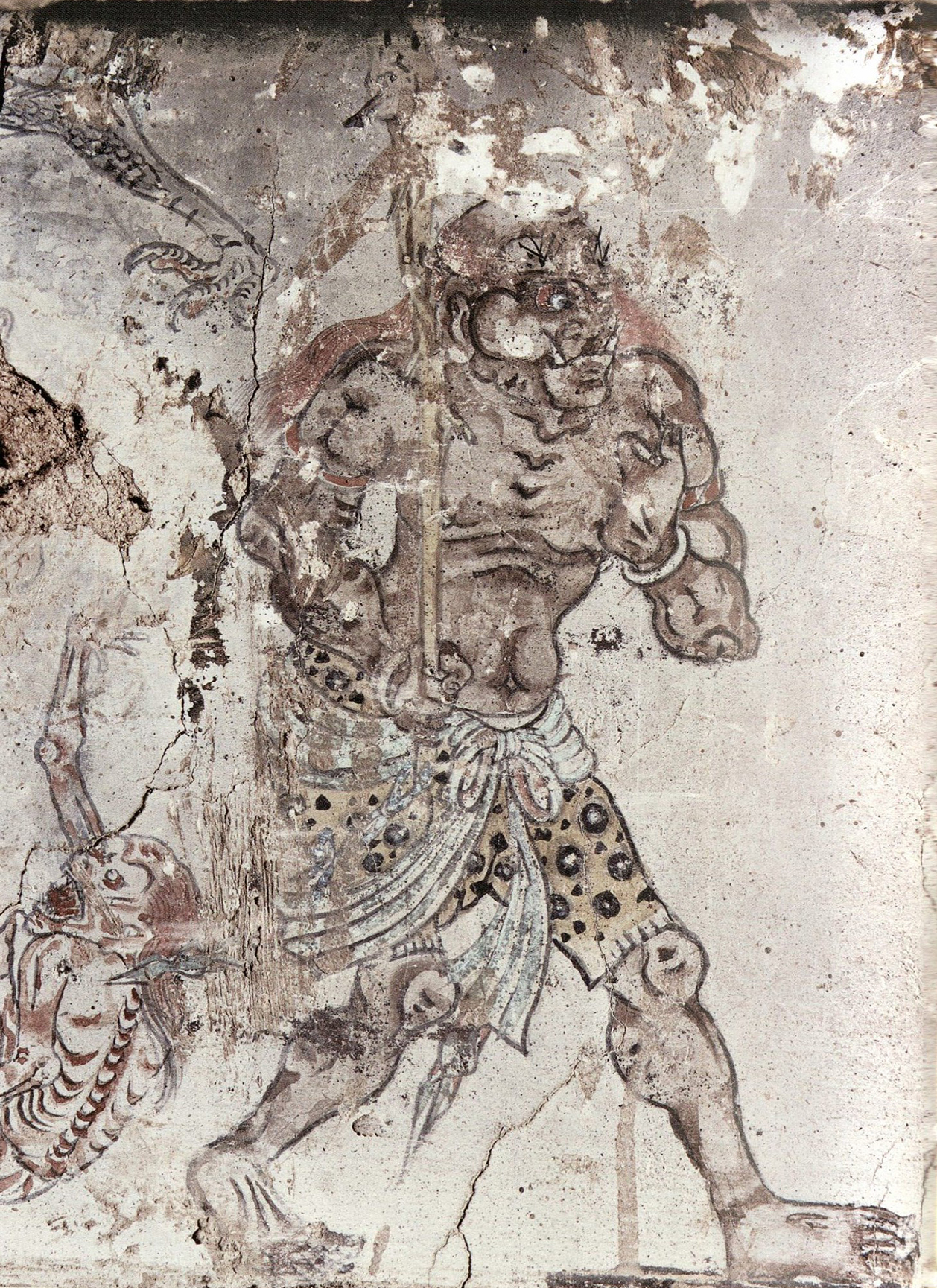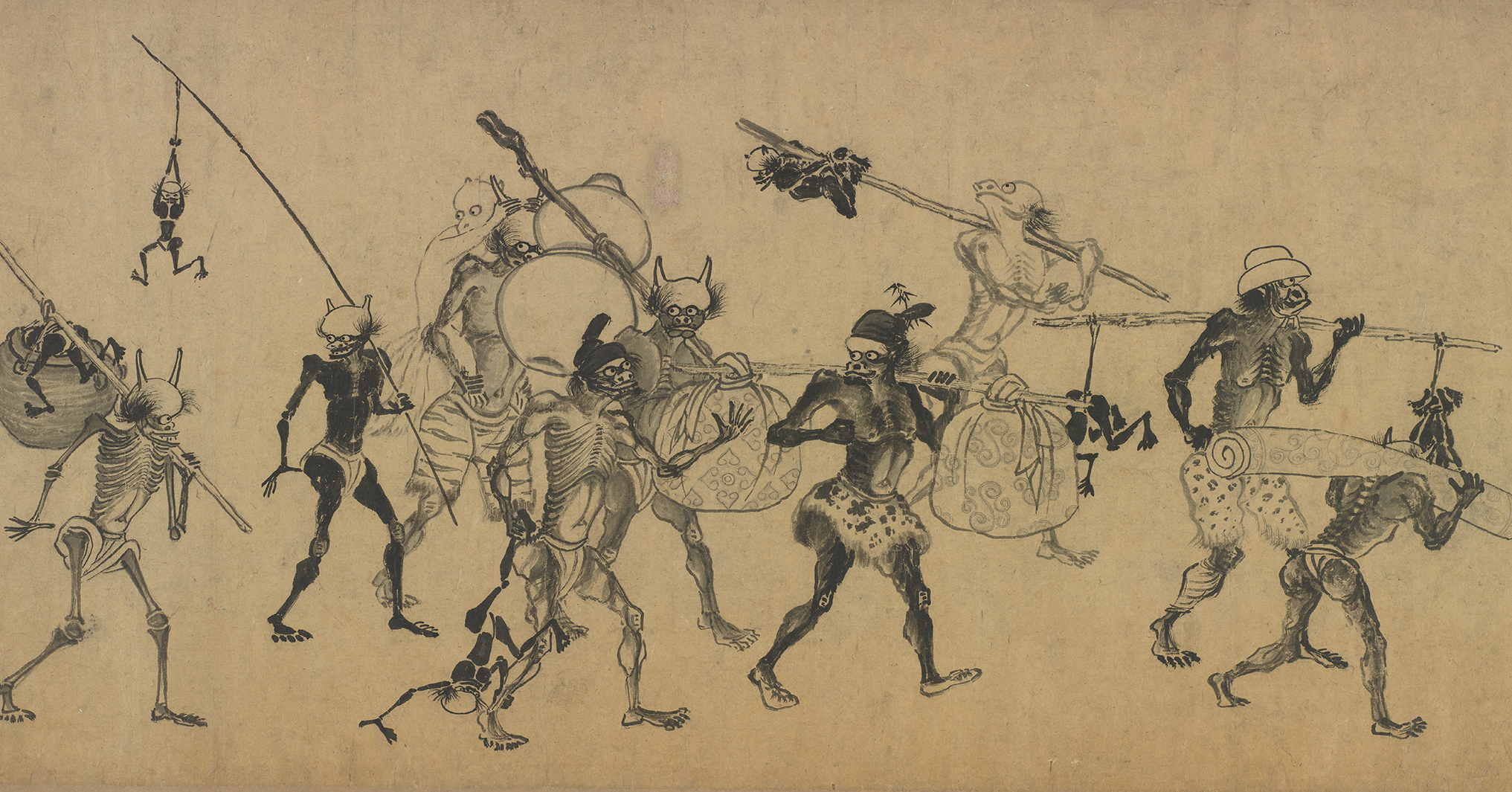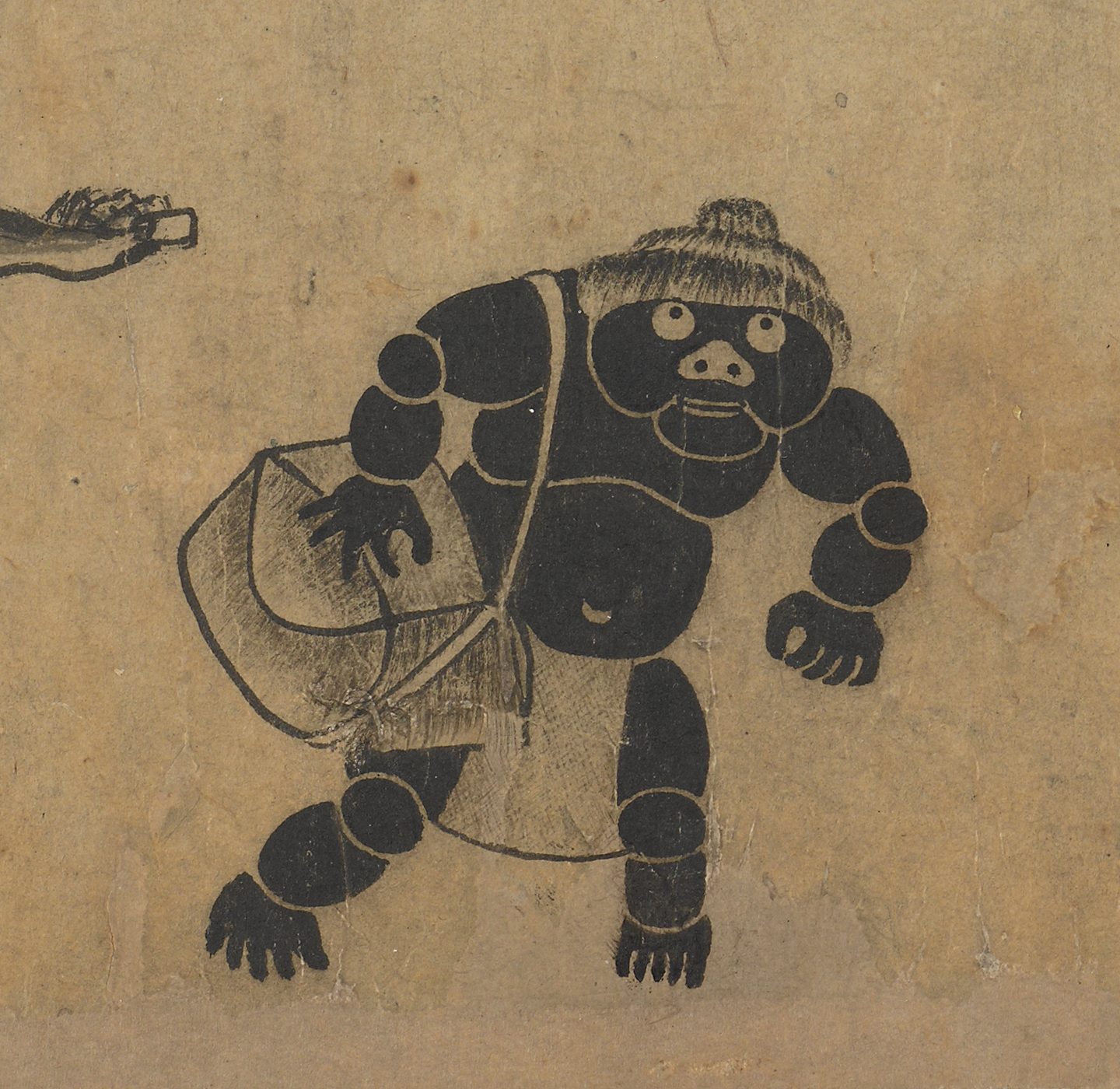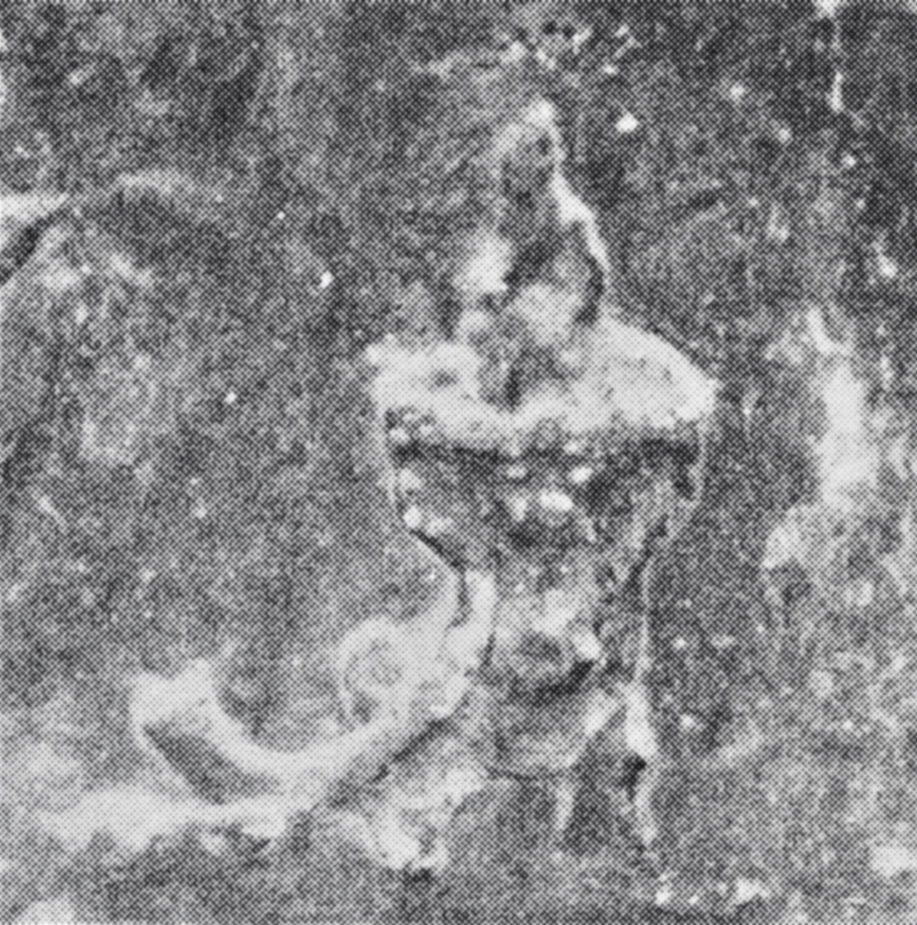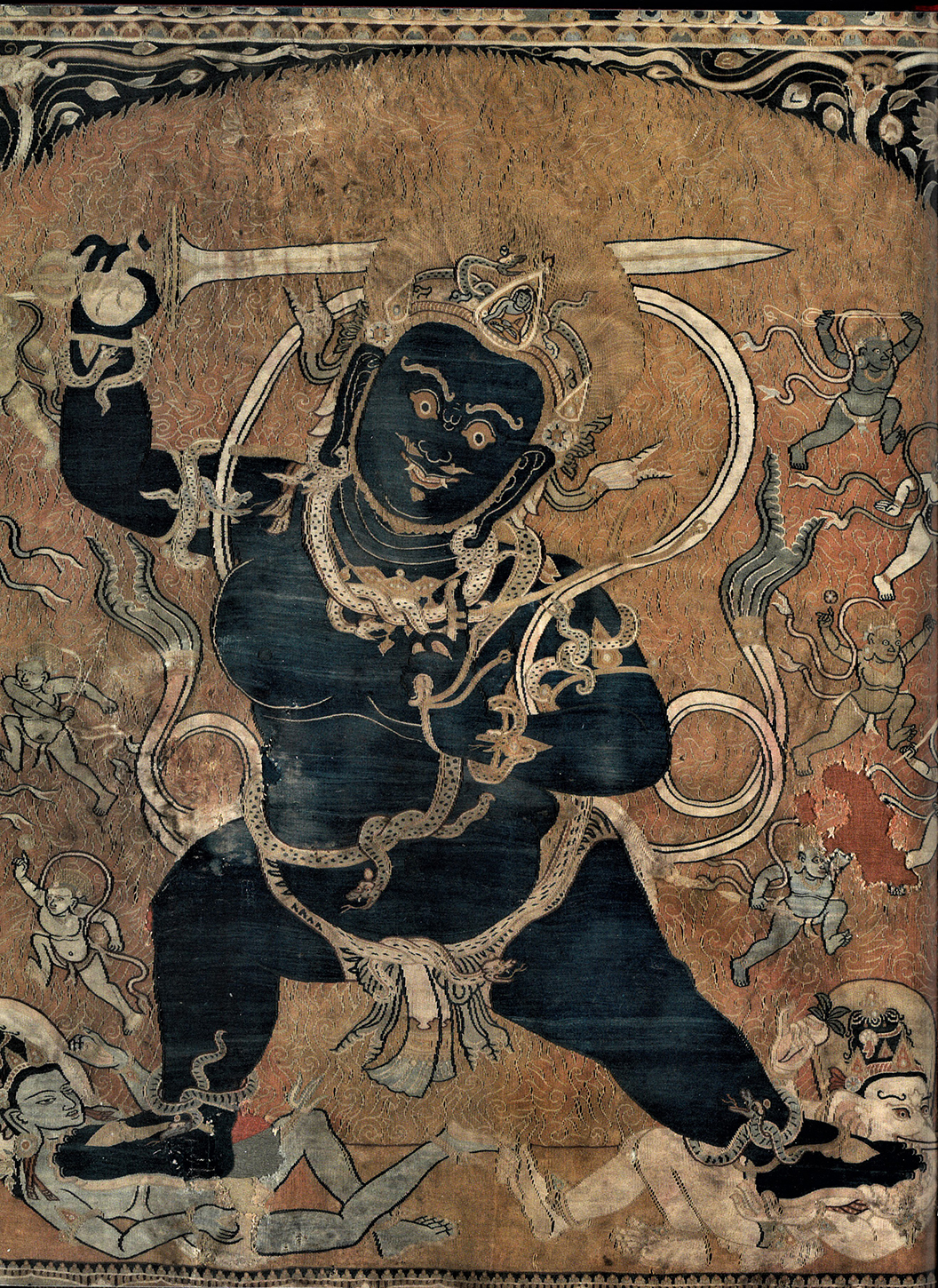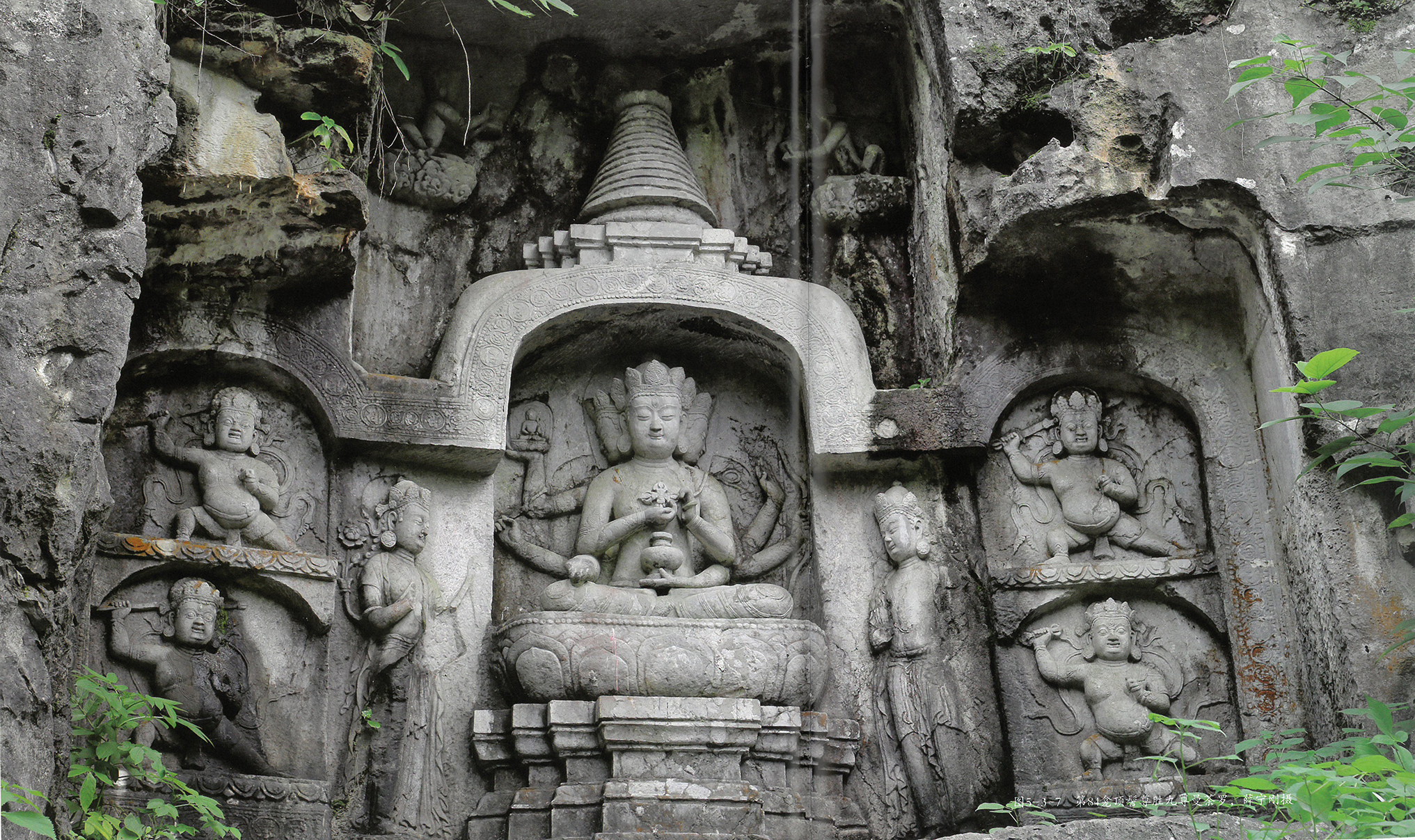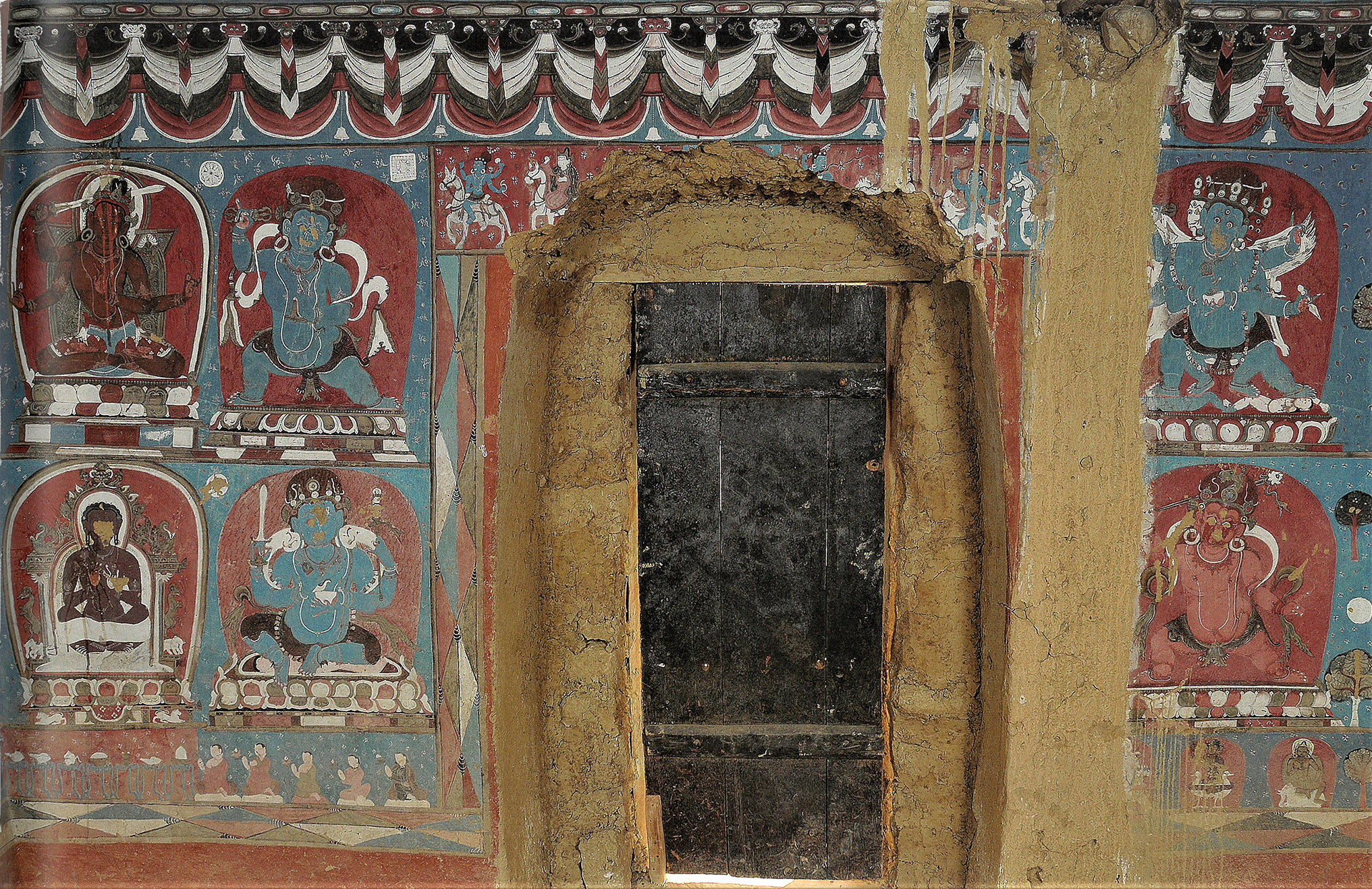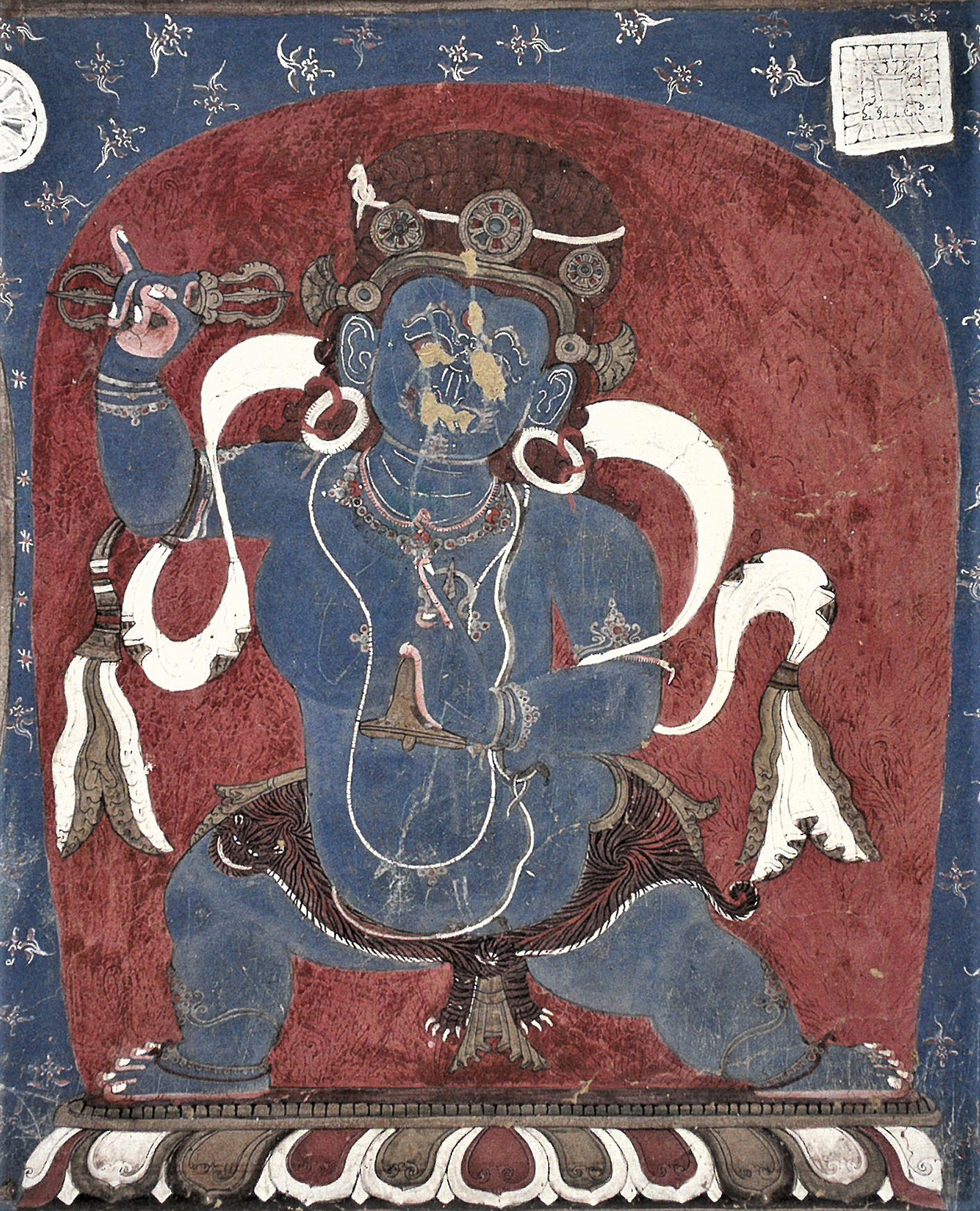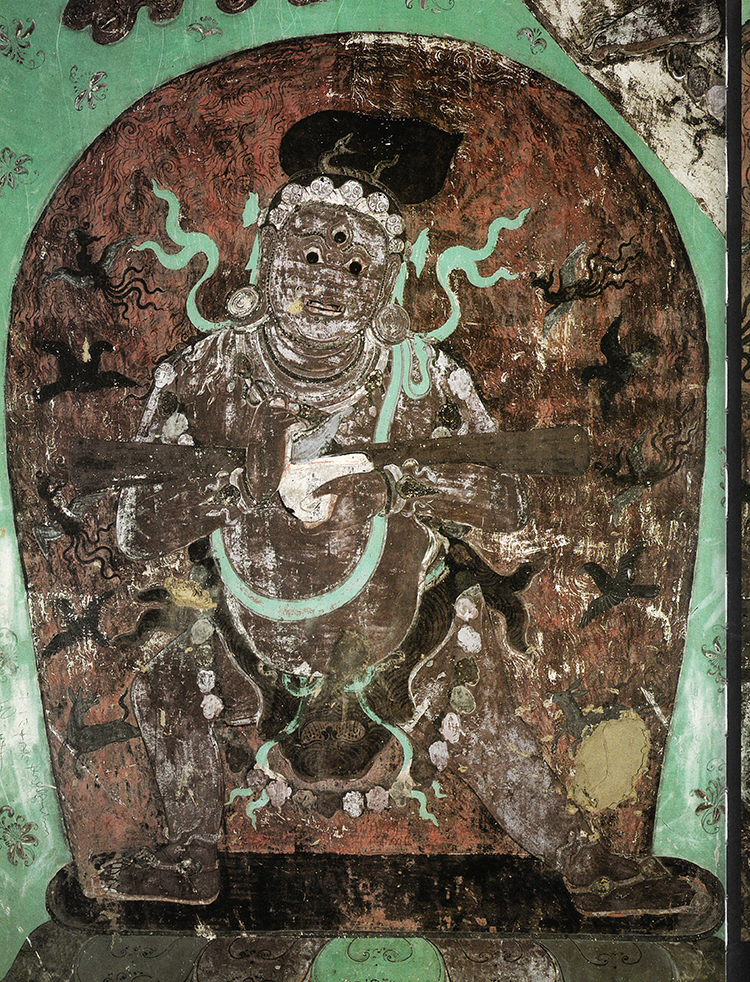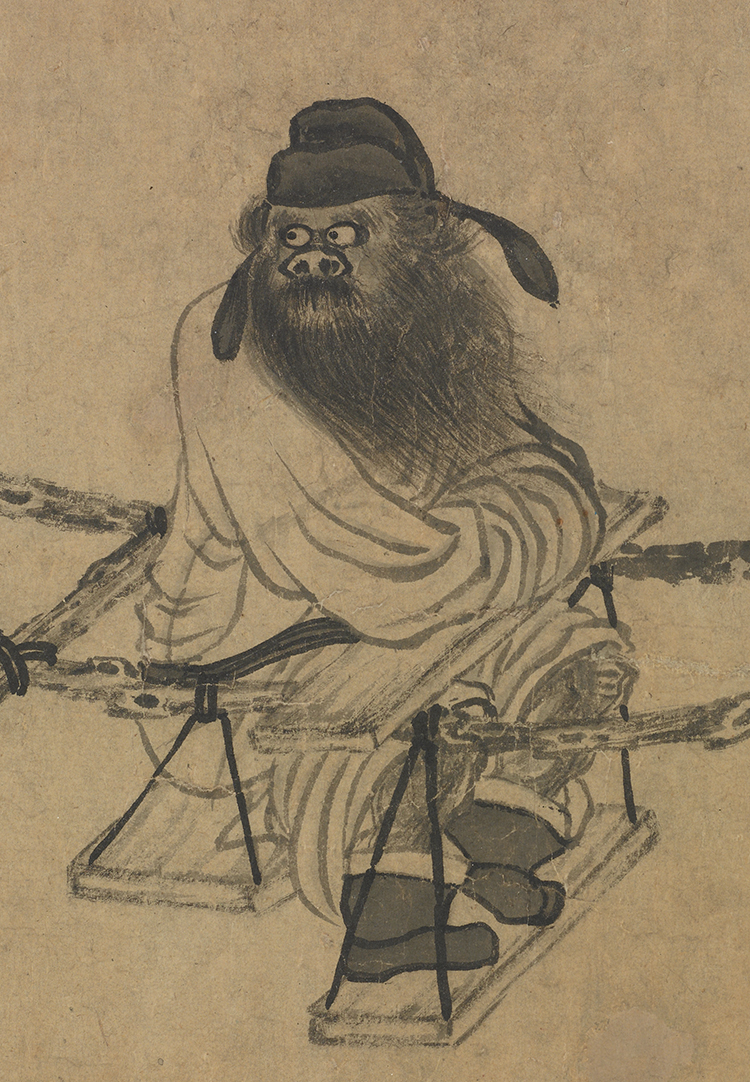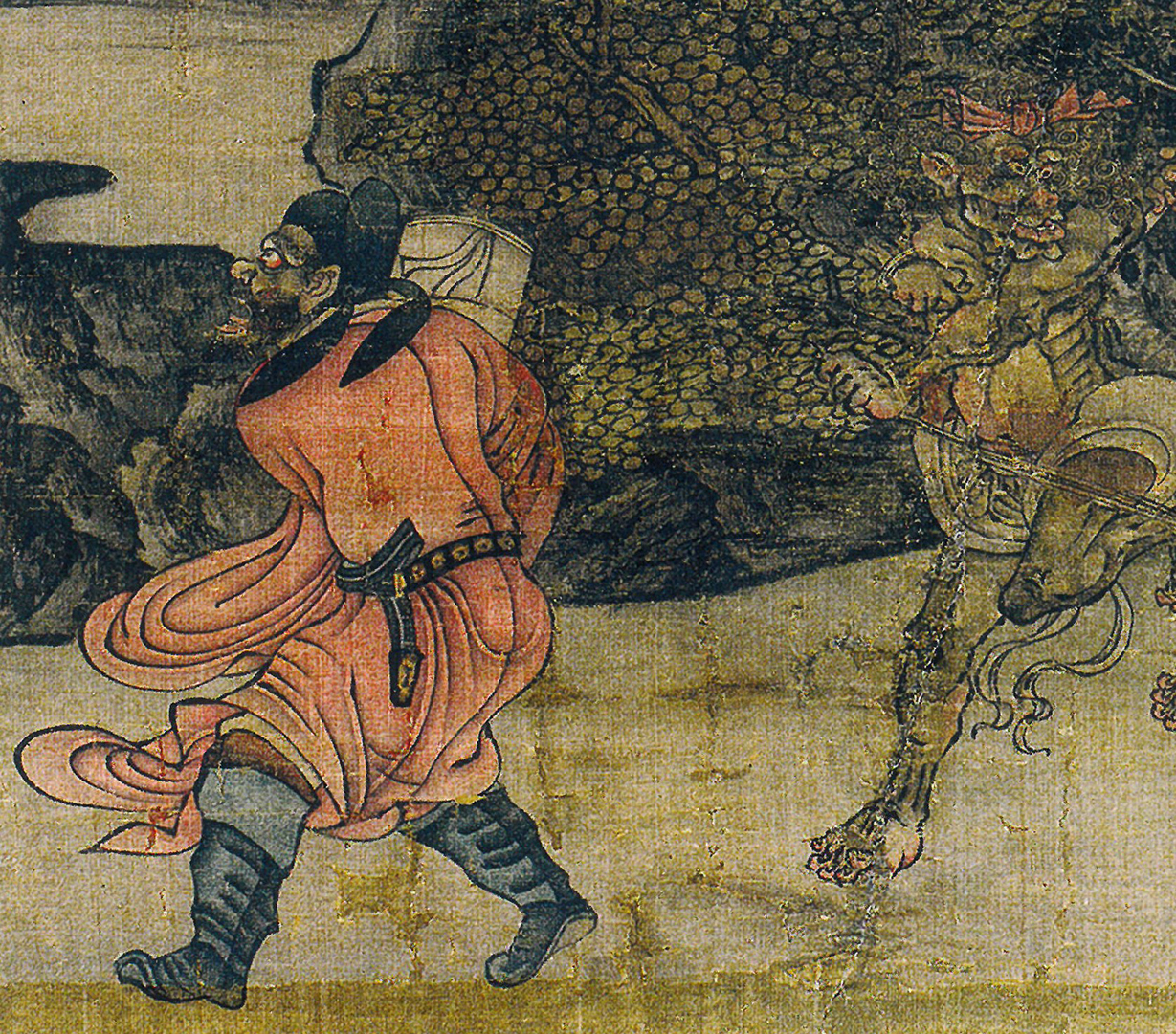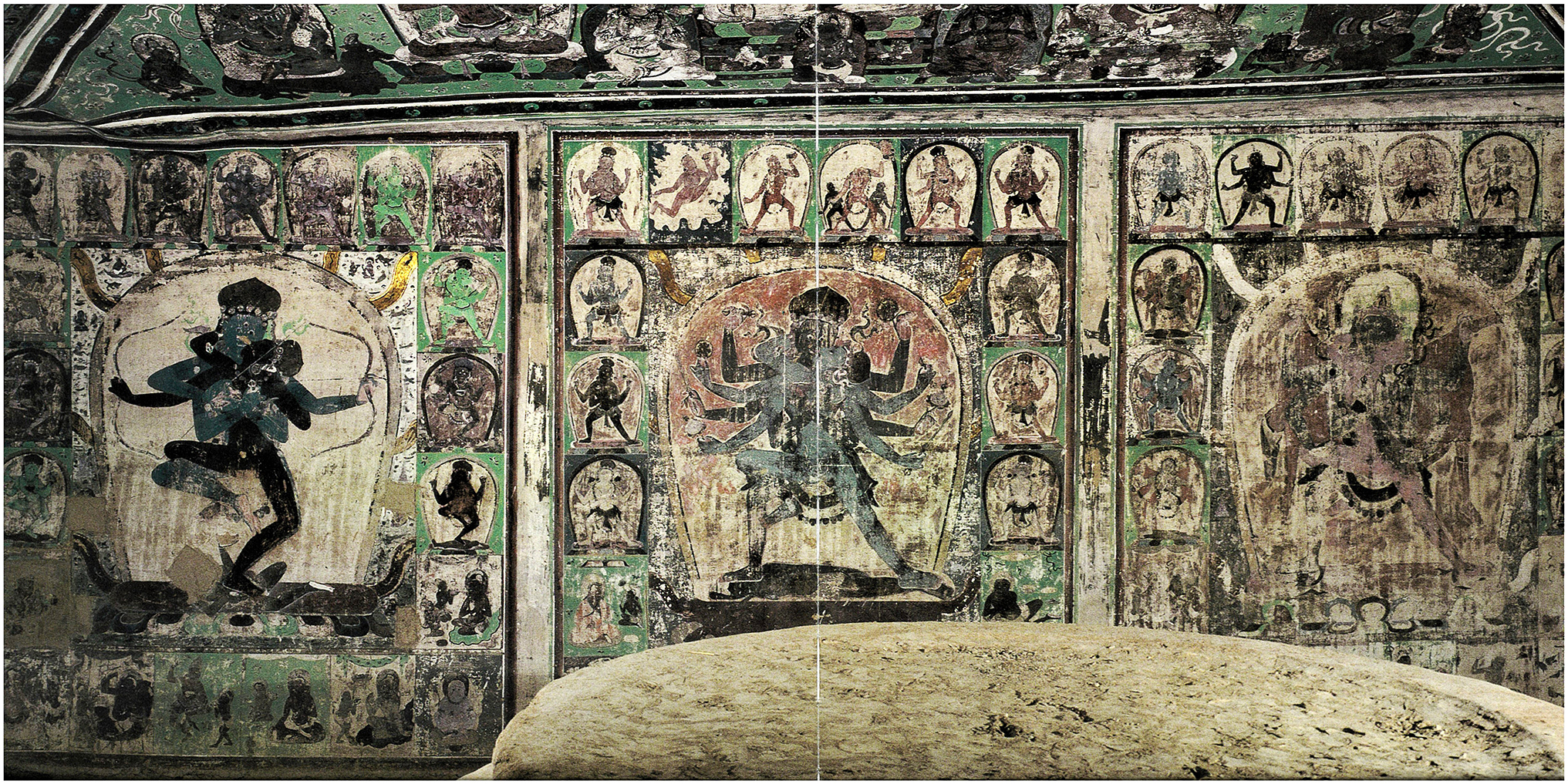The worship of Zhong Kui 鍾馗 began no later than the early Tang dynasty (618–907). Qie yun 切韻, Wang Renxu’s 王仁煦 (7th–8th century) rhyme dictionary completed in 706, states, “Zhong Kui, name of a deity.” The court minister Zhang Yue 張說 (667–730) and the writer Liu Yuxi 劉禹錫 (772–842) both wrote about the Zhong Kui paintings and the new calendars that they received from the emperors toward the end of the year. Evidently, by the Tang dynasty Zhong Kui had become a deity specializing in exorcising evil spirits and associated specifically with the annual cleansing at year’s end. These customs, practiced in society as well as at court, continued into the Song dynasty (960–1279) as documented by ever increasing activities and textual records.1
Originally a minor benevolent deity like the kitchen god, Zhong Kui had acquired a colorful biography with a vivid image, a strong character, and sensational anecdotes by the late Tang and through time established a personal myth with a cultish following. The narrative, with unknown origin, had been fully developed in the book Tang yishi 唐逸史 (Unofficial history of the Tang dynasty), a collection of tales about the occult that Song scholars, including Ouyang Xiu 歐陽修 (1007–1072), Song Qi 宋祁 (998–1061), and Ye Mengde 葉夢得 (1077–1148), regarded as compiled in the Dazhong 大中 era (847–859) of the late Tang, probably by Lu Zhao 盧肇 (818–882).2 It is beyond doubt that Tang yishi existed and was circulating in the tenth century because seventy-six entries from it were excerpted by Li Fang 李昉 (925–996) in his encyclopedic Taiping guangji 太平廣記, completed in 978.3 The entry titled “Meng Zhong Kui” 夢鍾馗 (Dreaming of Zhong Kui) in Tang yishi is therefore the earliest known text on the Zhong Kui myth.4 As preserved in Chen Yuanjing’s 陳元靚 (active in Song Lizong’s reign, 1224–1264) Suishi guangji 歲時廣記 (Encyclopedia of seasonal customs), it reads:
During the Kaiyuan era (713–742), Minghuang [the Tang emperor Xuanzong, 685–762, r. 712–756] fell ill with malaria after returning to the palace from a round of bow-and-arrow practice on Li Shan. While taking a daytime nap, he dreamed of a goblin, wearing only a red shirt, calf-snout shorts and one shoe—the other being tied at his waist—and holding a bamboo fan, in the act of stealing Taizhen’s [imperial consort Yang Guifei, 719–756] embroidered perfume-bag and his own jade flute while cavorting about the palace. Minghuang reproached it and demanded an explanation. The goblin respectfully replied, “Your servant’s name is Xuhao.” The Emperor responded, “I’ve never heard of you before.” The goblin explained that Xu stood for “stealing people’s belongings for fun” and hao for “replacing people’s joys with sorrows.” Enraged upon hearing this, the emperor was about to send for his guards, but a much larger demon in a tattered hat, blue robe, horn waist-belt, and black boots appeared and captured the goblin. He first gouged out its eyes, then tore it to pieces and ate it. When the Emperor asked him who he was, the large demon introduced himself as Zhong Kui, a jinshi from Mt. Zhongnan who, ashamed to return home after failing the civil service examination at the higher level during the Wude era [618–626], committed suicide by smashing his head against the palace steps. Grateful [to Emperor Gaozu, r. 618–626], who granted him an honorable burial of a court official of the green-robe rank, he had vowed to rid the world of all evil demons for the monarch. At these words, Minghuang awoke and found himself fully recovered. Without delay he summoned the painter Wu Daozi (ca. 685–758) to paint what he had seen in his dream. Wu Daozi went to work immediately and painted Zhong Kui as if he had seen him with his own eyes. When he presented his work to the Emperor, the latter perused it for quite a while and exclaimed with his hands still on the desk, “You and I must have had the same dream!” He awarded Wu one hundred taels of gold.5
夢鍾馗
《唐逸史》明皇開元講武驪山,翠華還宮,上不悦因痁疾作。晝寢,夢一小兒衣絳犢鼻,跣一足,履 一足,腰懸一履,搢一筠扇。盗太眞綉香囊及上玉笛,遶殿奔戲。上前上叱問之,小鬼奏曰:臣乃虚 耗也。上曰未聞虛耗之名。小鬼奏曰:虛者望空虛中盗人物如戲,耗卽耗人家喜事成憂。上欲怒呼 武士,俄見一大鬼頂破帽,衣藍袍,繫角带,靸朝[皁]靴,徑捉小鬼,先刳其目,然後擘而啖之。上問 大者:爾何人也。奏云:臣終南山進士鍾馗也。因武德年中應舉不捷,羞歸故里,觸殿階而死。是時 奉旨賜綠袍以塟之,感恩發誓與我王除天下虚耗妖孽之事。言訖夢覺,痁疾頓瘳。乃詔畫工吳道子 曰:試與朕如夢圖之。道子奉旨,恍若有賭,立筆圖就進呈。上視久之,撫几曰:是卿與朕同夢爾! 賜以百金。6
Another text of the Zhong Kui myth attributed to a Tang source is an inscription on a Zhong Kui portrait by Wu Daozi that was once in the Northern Song imperial collection, as recorded by Shen Kuo 沈括 (1031–1095) in Mengxi bu bitan 夢溪補筆談 (Supplement to the remarks from the Dream Brook).7 The narrative generally corresponds to that in Tang yishi, except that it states that Zhong Kui failed the military, rather than the civil, service examination and it includes an accolade by Tang Xuanzong, in which he orders pictures of Zhong Kui to be made and distributed broadly to officials at year’s end to ward off evil spirits.
Based on Lu Zhao’s and Shen Kuo’s remarks, Zhong Kui’s distinctive identity and dramatic image had been well established by the early Song. He was a native of Mt. Zhongnan to the south of the Tang capital Chang’an, and failed the civil or military service examination at the beginning of the dynasty. Unable to take office to serve his country in life, he pledged to expel all demons under heaven as a supernatural being. His defining feat was curing Emperor Xuanzong of his illness by devouring the goblin that haunted the palace. This exorcist operation, which took place in the emperor’s dream, was turned into a painting by Wu Daozi based on the verbal description.
From the tenth century on, pictures of Zhong Kui proliferated. By the early Yuan dynasty (1271–1368), the subject matter had expanded to include secular anecdotes of family gatherings, hunting, zither and chess playing, and so forth.8 Among the extant pictorial works that feature Zhong Kui, Gong Kai’s 龔開 (1222–1307) Zhongshan chuyou 中山出遊 (Zhongshan Going on Excursion) from the early Yuan in the Freer Gallery of the Smithsonian’s National Museum of Asian Art is the earliest (fig. 1).9 According to the Yuan critic Xia Wenyan 夏文彥 (1296–1370), Gong Kai “specializes in depicting demons in ink monochrome, Zhong Kui, and the like in a uniquely strange style of his own.”10 The Freer scroll is exemplary of his originality and strangeness.
The painting depicts a procession of twenty-one travelers on the move and consists of three sections. It begins at the right, where a thick-bearded man in official attire sits in a sedan chair carried by two demonic servants; he is followed by two more, one shouldering a long sword and the other carrying what is probably a large cushion on his back. Lingering below the official is a squat demon, rendered in solid black ink, that looks typologically distinct from all other attendants. The middle section shows an elegantly dressed woman seated in a sedan chair carried by two maids and followed by three more. While the maid holding a cat in her arms shares with the seated lady similar facial features, hairstyle, and flowing floor-length gown, the other four are dressed with exotic flair, and their grotesquely protruding jaws and animalistic upturned noses identify them as nonhuman. The third section presents a group of nine demonic attendants carrying household goods, including a rolled-up rug, a gourd jar of extraordinary size, and several wrapped parcels, as well as six captive imps and a ghostly creature with multiple tails.
The painting is followed by Gong Kai’s long colophon written in clerical script that consists of a poetic new biography of Zhong Kui followed by a prose critique of earlier representations of him and his own revisionist take on the subject (fig. 2). It reads:
The bearded gentleman originally resided in [the wine country] Zhongshan.11 He claimed to be on an excursion, [but] where was he headed? Some said he intended a small hunt, yet there were no hawks nor hounds; Others believed he went jaunting on a whim, but his wife12 was tagging along. 4 Her beautiful face was adorned with cosmetics;13 Of the various shades of makeup, black suited her best. On the way they arrived at a postal relay station and took a rest, But who could serve them food and wine in that old building? 8 The creature wearing a red headwrap and the other a black garment could certainly be cooked.14 The pure blood of the beauty, however, was beyond reach after all. Better to go home to enjoy the wine of Zhongshan and Once drunk, for three years remain oblivious to the world. 12 Yet the prospect of certain creatures spying on the throne was worrisome; Bayi [Lady Qinguo, an elder sister of Yang Guifei’s] encroached on people’s properties. By the time he sobered up and was expected to sweep the world clean, The golden load at Mawei [where Yang Guifei was executed] had vanished without a trace. 16
People say that painting demons in ink is a mere play of the brush. How wrong they are! [Paintings as such] are comparable to the cursive script in calligraphy. Was there anyone capable of writing in the cursive script without mastering the standard script first? Painters famous for painting demons in ink from the past include Si Yizhen (11th century) and Zhao Qianli [Zhao Boju 趙伯駒, ca. 1120–ca. 1170]. Qianli’s Clove Demon painting was certainly unique, but it was so different from typical figure paintings that people regarded it as a mere play of the brush. Although Yizhen’s demon paintings are highly crafted, their message is vulgar and shallow. In an extreme case, the bearded gentleman is depicted in a latrine [or pigpen] in the fields approached by a porcupine, while his younger sister, with the collar of her clothes still open, drives it away with a stick. What’s the intent of such paintings? Now I’ve painted Zhongshan on an Excursion to clear the vulgarity of Yizhen’s work so as not to spoil the pure delight of brush and ink. Compared to calligraphy, this painting falls between the standard and the semi-cursive scripts. Anecdotes of Zhong Kui are extremely scarce.15 I have composed poems on him from past to present and found it hard to avoid repeating myself. This one was conceived in response to previously unreferenced events in hopes of generating new meanings. Noted by Gong Kai of Huaiyin [in northern Jiangsu].
髯君家本住中山,駕言出遊安所適。 謂為小獵无鷹犬,以為意行有家室。 阿妹韶容見靚籹,五色胭脂最宜黑。 道逢驛舍須少憩,古屋何人供酒食。 赤幘烏衫固可亨[烹],美人清血終難得。 不如歸飲中山釀,一醉三年萬緣息。 卻愁有物覷高明,八姨豪買他人宅。 囗囗[待得]君醒為掃除,馬嵬金馱去无跡。
人言墨鬼為戲筆,是大不然。此乃書家之艸聖也,世豈有不善真書,而能作艸者?在昔善畫墨鬼, 有姒頤真、趙千里。千里《丁香鬼》誠為奇特,所惜去人物科太遠,故人得以戲筆目之。頤真鬼雖甚 工,然其用意猥近,甚者作髯君野溷,一豪豬即之,妹子持杖披襟趕逐,此何為者耶?僕今作《中山 出遊圖》,蓋欲一洒頤真之陋,庶不廢翰墨清玩。譬之書,猶真、行之間也。鍾馗事絕少,僕前後為 詩,未免重用,今即他事成篇,聊出新意焉耳。淮陰龔開記。
The painting does not depict the acrobats or musicians that characterize festive parades as described in Song texts and shown in the other two procession scenes featuring Zhong Kui from about the same time period: Yan Hui’s 顔輝 (act. 1270–1310) Lantern Night Excursion of Zhong Kui in the Cleveland Museum of Art and Zhong Kui Giving His Sister Away in Marriage in the Metropolitan Museum of Art, with an unverifiable signature of Yan Geng 顔庚 (late 13th century?).16 Gong Kai says that his painting is not about hunting or an impromptu jaunt (lines 3, 4). With an array of cumbersome household goods in addition to his wife, maids, and a pet, all of which are not only unrelated to religious rituals but also hamper their performance, Zhong Kui could hardly be on an exorcist mission. The enigma of the painting is deepened by the colophon, in which Gong Kai constructs a new biography of Zhong Kui that is barely related to the existing one but mirrors the painter’s own life instead. His creation, he says, was conceived “in response to previously unreferenced events” (jitashi 即他事) and intended to rectify the frivolous, shallow, or vulgar representations of Zhong Kui in the past with “new meanings” (xinyi 新意), signaling a serious revision that goes beyond original sources.
This pictorial puzzle has stimulated various interpretations in modern scholarship, mostly in relation to Tang Xuanzong’s court, which Gong Kai repeatedly alludes to in his colophon.17 The “previously unreferenced events” that had inspired him, however, may be contemporary rather than historical. This essay probes the two motifs of the exotic maids and the squat black demon that have no textual references or pictorial precedents in the representation of Zhong Kui. They may have been invented to evoke the grave crimes committed by a Muslim merchant-official in Quanzhou and a Tibetan Buddhist monk in Shaoxing during the Song-Yuan dynastic transition, which, as will be demonstrated in detailed discussions below, Gong Kai knew firsthand. Conflating himself with Zhong Kui by constructing a new, self-referential biography and image of the demon queller, he projects his unfulfilled aspiration to clear the nation of its current demons, that is, the powerful and villainous ethnic others, not limited to the ruling Mongols. He conveys his xenophobia by casting the Central and West Asian and the Tibetan motifs in the painting in a negative light and reveals his resignation to the brutal new social order through the uncharacteristically subdued image of Zhong Kui.
Gong Kai’s Life in the Twilight of the Southern Song
Gong Kai’s life spanned the last five reigns of the Song dynasty into the first thirty years of the Mongol rule of China (1276–1368). His nationalist devotion began with active affiliation with anti-Mongol forces in the 1260s and 1270s and ended with literary and pictorial expressions of loyalist sorrow after the demise of the Song in 1279. The historical context is essential to understanding his complex and multivalent Zhong Kui scroll.
The Southern Song (1127–79) experienced a dramatic decline under the reigns of the emperors Lizong 理宗 (1205–1264, r. 1224–1264) and Duzong 度宗 (1240–1274, r. 1264–1274). With the capital Lin’an (modern Hangzhou) under siege by the Mongols at the beginning of 1276, the Song court, led by Empress Dowager Xie 謝太皇太后 and four-year-old Emperor Gongdi 恭帝 (1271–1323, r. 1274–1276), considered establishing an exiled government in Fujian or Guangdong. They appointed Gongdi’s two half-brothers, seven-year-old Zhao Shi (趙昰, 1269–1278, r. 1276–1278) and four-year-old Zhao Bing (趙昺, 1272–1279, r. 1278–1279) to oversee Fuzhou and Quanzhou, respectively.18 After Gongdi officially surrendered to the Mongols on the eighteenth of the first month (February 4, 1276) and was taken prisoner,19 the two child-princes and their clan, escorted by a group of officials and military commanders including Chen Yizhong 陳 宜中 (1218 or 1234–1283), Zhang Shijie 張世傑 (d. 1279), and Lu Xiufu 陸秀夫 (1236–1279) arrived in Wenzhou 溫州 in southern Zhejiang and then moved to Fuzhou, where Zhao Shi ascended the throne as Emperor Duanzong 端宗 on the first of the fifth month. After the fall of Fuzhou in the tenth month, the exiled Song court moved to Quanzhou in the eleventh month of 1276. Unable to make this port city their base of resistance, they left after a short stay and went farther south to Guangdong. Upon Duanzong’s death in Guangzhou in 1278, Zhao Bing was enthroned. In the spring of 1279, Mongol forces intensified their attack at Yashan 崖山 on the coast of Xinhui 新會, Guangdong, and vanquished the entire Song defense on the sixth of the second month (March 19, 1279). Determined not to be taken captive by the Mongols, Lu Xiufu took the young emperor with him and jumped into the sea, marking the end of the dynasty. Lu Xiufu’s heroic act made him one of the most revered martyrs in the Song revivalist campaign.20
Information about Gong Kai’s early life is scarce. The few sources are all closely related to Lu Xiufu. Both men were on the staff of Li Tingzhi 李庭芝 (1219–1276), military commissioner (Zhizhi shi 制置使) of the Huai River region based in Yangzhou, in the 1260s and got along well. Gong Kai handled taxes on salt, tea, and wine. When Li and Lu went to relieve Xiangyang, Hubei province, from the Mongols’ siege in the spring of 1270, Gong Kai was left idling in Yangzhou for three or four years. After the fall of Hangzhou in early 1276, Lu Xiufu and other officials escorted the two imperial child heirs to Fujian. According to Wu Lai’s 吴莱 (1297–1340) poem “Guan Huaiyin Gong Cuiyan suo xiu Guqi jing” 觀淮隂龔翠巗所脩古棋經 (On the ancient classic on chess edited by Gong Kai of Huaiyin), Gong Kai joined the Song troops in exile.21 The poem begins with Gong Kai in the Yangzhou camp playing chess at leisure while the battle in Xiangyang rages on. After the Southern Song loses the war, Gong Kai is with the military escorting the exiled court south. The poem relates the eventual ending of the Song with the deaths of Lu Xiufu and the last Song emperor, followed by the Mongol unification of the empire.22 The last lines of the poem read:
In the mountains of Sichuan, the mistress and her sister-in-law played chess [verbally] in thirty-six moves In a shabby house with dark rooms unlit by candles. Overnight they transmitted their craft to Wang Jixin. Back in Chang’an [the capital], the dust from the barbarians’ horses was everywhere.
蜀山婦姑三十六,破屋數間昏不燭。 夜來教得王積薪,滿眼長安胡馬塵。
As Yuan Shishuo and Abe Shin’ichirō have noted, these lines allude to a tale in the Jiyi ji 集異記 (Collected records of the extraordinary) from the Tang dynasty. During the An Lushan rebellion, Wang Jixin, a court chess player, followed Tang Xuanzong into exile to Sichuan. While staying overnight at a commoner’s home, he was taught the art of the game by two women and became the preeminent chess player. Through this classical allusion, Wu Lai relates Gong Kai’s whereabouts after the fall of Lin’an. Like Wang Jixin, Gong Kai was an advanced chess player who followed the emperor into exile to remote provinces and later returned to the capital, where traces of alien occupation were everywhere.
In the late 1280s and early 1290s, Gong Kai invited twelve friends to compose elegies for Lu Xiufu and received eighteen in addition to the one by himself.23 In his preface to this collection, composed in the third month of 1292, he states, “In the past when I returned from southern Quanzhou 泉南 to western Zhejiang 浙西, I heard the news of his death and was saddened beyond myself.”24 Quanzhou was a stop on the exile route of the Song court, and Hangzhou was one of the three counties of western Zhejiang. Gong Kai’s statement corroborates Wu Lai’s poem regarding his participation in the Song revivalist campaign in Quanzhou and his return to Hangzhou afterward. The news of Lu Xiufu’s martyrdom in the second month of 1279 must have reached Hangzhou no later than the winter.25 Gong Kai therefore might have returned to Hangzhou in late 1279. His activities in later years were concentrated in Hangzhou,26 and the Zhong Kui scroll was most likely created there.
Maids in Exotic Attire: Anti-Muslim Xenophobia
In the middle section of the Freer scroll are five attendants to a lady seated in a sedan chair (fig. 3). While one attendant holding a cat wears Chinese-style clothing and her hair is arranged in the Chinese style, the attire of the other four exhibits prominent sartorial characteristics of the peoples of Central, West, and South Asia, whom medieval Chinese generalized as Muslims (Huihui 回回), lacking the knowledge to distinguish their ethnic and religious identities. The four figures consist of two sedan-chair carriers, a pigtailed girl carrying a large parcel with her left hand, and a tall figure who sports a knotted headwrap and holds a bundle. Strikingly exotic, this headwrap features layered bands of cloth crisscrossing diagonally from the temples upward to form an angle at their intersection on the forehead (fig. 4). It differs from the traditional Chinese headwrap, which covers the hair and is fixed with a knot either to the side (fig. 5) or at the back of the head (fig. 6). Instead, it echoes a type of turban worn by people from the Arab world as seen on a terracotta figurine of a Central or West Asian male excavated from an early Yuan tomb in Xi’an, Shaanxi province, in northern China (fig. 7).27 In that work, the cloth strips are twisted into ropes before crisscrossing diagonally and framing the extra cloth on top. The figurine, created by Chinese craftsmen, credibly represents a Muslim laborer active in China in Gong Kai’s time.
All four maids wear the same narrow fitted shoes with pointed tips that generously expose the tops of the feet. Their distinctive shape does not seem to have counterparts in extant pictorial representations or archaeological finds in Chinese culture.28 Instead, shoes of this type were worn by men and women in the Islamic world for centuries, as seen, for instance, on the old man and the child in an illustration from a thirteenth-century manuscript of the Maqâmât (Assemblies) by the Arab poet al-Hariri (1054–1122) (fig. 8), and on the female figure painted on the interior of a bowl from twelfth- or thirteenth-century Iran (fig. 9).
As to clothing, the two sedan-chair carriers and the turbaned attendant each wear a knee-length garment known as a beizi 背子 or 褙子, with narrow sleeves, a straight collar leading to a bordered open front, and high side slits, that was popular among women across social strata in the Song dynasty (fig. 3).29 Underneath it, they wear a breast cover known as a moxiong 抹胸, tied at the waist in the back and behind the neck.30 A typical example of this combination is the attire of the house maids carved on the walls of a Song tomb in Luxian, Sichuan (fig. 10).31 Even the extended right sleeve of the turbaned attendant has a Song prototype in the Luxian stone relief (fig. 11).
Turning to the lower body, the trousers on Gong Kai’s demonic maids are not in the Chinese tradition. The trousers worn by working-class women in Song China, either under a garment (fig. 12) or a tucked-up skirt, or alone (fig. 13), had voluminous legs that ended in rumpled pleats gathered around the ankles and partially concealing the feet, while their shoes were of a sturdy type with rounded toes.32 All four demonic maids, on the other hand, wear the same straight, loosely flowing trousers with the hems suspended from the ankles, which enables a full view of their feet clad in non-Chinese pointed shoes. The trousers, clearly displayed in the image of the turbaned attendant (fig. 14), resonate with a type of pants known as shalwar and fairly common in West and South Asia, which features straight legs and usually ends above the ankles. Although normally worn underneath a calf-length tunic, the wraparound skirt of a yogini in a painting from the Jami’ al-tawarikh (Compendium of chronicles), created in Tabriz, Iran, in 1314–15, reveals a more complete view of the shalwar through its open front (fig. 15). Gong Kai’s demonic maids appear to be wearing similar pants. Many sartorial items worn by men and women were identical across the Islamic world from the time of the prophet Muhammad (d. 632) through the centuries.33 As suggested by decoration on medieval works of art, both men and women wore this type of trousers and narrow pointed shoes (figs. 8, 9).
It is also noteworthy that the trousers worn by Chinese working-class women were rustic and usually plain, while those of the four demonic maids are decorated with allover patterns, more characteristic of Indian or Persian aesthetics as exemplified by the yogini’s trousers in figure 15. Specifically, the paired wavy lines on the fabric of her trousers closely resemble those worn by the pigtailed girl in Gong Kai’s painting (fig. 16). This design became common under the Ottomans, who ascended to power in 1299 and expanded territorial control from their base in West Asia to southeastern Europe and North Africa in the ensuing centuries.34 In the late thirteenth century, the motif, despite its possible origin in East Asia, may have been already popular in West Asia when the region was under Mongol rule. Since its application to clothing does not seem to have examples in China, whereas the image of the yogini witnesses its integration in female costume design in thirteenth- to early fourteenth-century West Asia, Gong Kai’s unprecedented decoration of the pigtailed girl’s trousers with paired wavy lines was most likely inspired by the sight of Muslim women on the streets of early Yuan Hangzhou.
Most exotic is the dark coat with a Y-shaped opening at the front and long narrow sleeves, also worn by the pigtailed girl (fig. 16), which recalls a type of Muslim outer garment broadly known as a kaftan with varied forms across regions and through time. In its typical design, “the garment is open down the center front. . . . Buttons and loops typically close the kaftan at the center front to the waist. Sleeve styles vary. . . . Long, narrow sleeves would extend beyond the wrist, but they are designed to be worn pushed back, so that the fabric gathers in pleats on the lower arm.”35 The right sleeve of the pigtailed girl is very long, while the left one is pushed back to gather near her wrist. Unlike the front opening of the Chinese beizi, which was either unfastened or tied with ribbons, the right and left front panels of her coat overlap at the straight borders under the V-shaped collar, which suggests the use of buttons and loops. Unseen in Chinese costume of this time, the coat compares well with the gray coat with light blue borders along the overlapping front panels of a seated girl painted on the interior of a bowl from twelfth- or thirteenth-century Iran (fig. 17) and a lady’s yellow coat in a Persian miniature from around 1430 (fig. 18), demonstrating the continuity of this design in female Muslim clothing.
Gong Kai’s references to Central and West Asian sartorial elements in his portrayal of female demons are unprecedented and raise questions regarding, first of all, his imagistic sources. By the early Yuan, Muslims had been in Hangzhou for almost four centuries.36 While Guangzhou remained the major port for maritime trade in the Northern Song, Hangzhou, located at the southern end of the Grand Canal, played an increasingly important role. In 978 a Maritime Trade Superintendency (Shibosi 市舶司) was established there to oversee foreign trade at all the ports in the Zhejiang region, making it a cosmopolitan center of commerce on a par with Guangzhou, Quanzhou, and Mingzhou (Ningbo). As Hangzhou became the capital of the Southern Song, the new arrivals of foreign envoys with their families, in addition to traders, further enhanced its demographic diversity. The majority of its wealthy residents were non-local merchants engaged in the maritime trade. They included many Arabs and Persians who were Muslims living in closely knit communities.37
Zhou Mi 周密 (1232–1298), a key figure in the cultural sphere of early Yuan Hangzhou, once stated: “Nowadays Muslims make China their home, especially in the Jiangnan region. It’s natural that they no longer look back at their homeland.”38 Their sojourn in China, as noted by Xu Youren 許有壬 (1286–1364), hardly changed their Muslim way of life.39 Xu’s observations are borne out by Zhou Mi’s account of the burial practice of a local Muslim community that he witnessed outside his residence in the spring of 1291.40 At the end of a vivid description of the hectic procedures, he continued: “On a suitable day the coffin is taken out and interred in the Jujing Yuan 聚景園. This garden is in the charge of a Muslim. The rent of every plot of land has a regular price, and the overseer of the garden has all the bricks, mortar and labour used, which he sells for money.”41 The Jujing Yuan was originally an imperial garden of the Southern Song.42 Its gradual conversion to a professionally managed, full-scale Muslim cemetery as described by Zhou Mi must have taken decades, attesting to a substantial Muslim population at the time.43 The non-Chinese sartorial traits in Gong Kai’s painting all but certainly derived from direct observation.
Gong Kai left no verbal comments on Muslims or their customs. The prominent Central and West Asian elements in the attire of the demonic maids in his painting, however, reveal his knowledge of this ethnic group, and his curious portrayal of these figures may shed light on his impressions of Muslims. Unlike the preceding Tang dynasty, when “barbarians’ costumes” (hufu 胡服) were openly embraced across social strata, during the Song edicts that banned hufu may have begun with Huizong (r. 1100–1126) in 1119 and lasted until 1185, during Xiaozong’s reign (1162–1189), if not later.44 At the time, the sartorial infiltration came primarily from the northern nomadic minorities, the Khitans and the Jurchens who occupied northern China in particular.45 There seem to be no textual or pictorial references to the naturalization of Central and West Asian costumes in the Song or early Yuan. Random adoptions, however, may have existed in interethnic households. Zhou Mi’s remark that many Muslims of his time made China their permanent home suggests their marrying local Chinese women to start families. In 1271 Khubilai Khan (r. 1260–1294) decreed that in interethnic marriages the customs of the male be prioritized.46 Muslim attire, therefore, might have been more common than Chinese dress in these households, worn either alone or in hybrids. Muslim attire might have been notable in public, but as daily wear was probably limited to interethnic households, it did not form a trend, which may explain the lack of textual and pictorial records.
Gong Kai may have taken inspiration from this social phenomenon in creating the demonic maids in his painting. Female demons are rare in Chinese pictorial art. Without any established prototype, he was free to represent them at will. His references to Muslim customs step beyond Chinese conventions of ghostly imagery. Thoroughly original, the new images of the maids could be amusing, spicing up the painting with humorous touches like the two mischievously grinning male demons walking right in front of them. The rear sedan-chair carrier grimaces, with her tongue hanging out of the left corner of her mouth below a conspicuous flaring nostril, while the bridgeless nose and the mouth of the maid at the front merge into a pointed snout like a bird’s muzzle (figs. 19a,b). Gong Kai’s professed goal to rectify the frivolous vulgarity of earlier Zhong Kui paintings with serious new meanings, however, prompts a moral perspective on their humorous bestial features that connotes aberration from humanity. More directly, his idiosyncratic characterization of the pigtailed girl and the turbaned maid invites scrutiny.
Like Zhong Kui’s wife and her human maid, the cheeks, chin, neck, and upper chest of the pigtailed girl are painted black, which could refer to her identity as a member of Zhong Kui’s household, since heavy makeup was employed by practitioners of the exorcist nuo 儺 ritual.47 But peculiar to her, the only figure in exclusively Muslim attire in the painting, her forehead is marked with two Chinese characters “ba 八” (eight) and “shi 十” (ten) (fig. 20). As a phrase with meaning and executed with modulated calligraphic strokes, it is not a decorative pattern of facial makeup but a traditional form of penal face tattoo known as qingmian 黥面 or mo xing 墨刑 (corporal punishment with ink) practiced since the Zhou dynasty (ca. 1050–221 BCE).48 During the Song, the number of applicable transgressions reached 570 by the year 1187.49 Runaway servants were among the inflicted multitude as early as the Jin 晉 dynasty (266–420).50 The tattooed texts for minor offenses are rarely recorded. There is no way to tell whether the two characters for bashi meant anything or were randomly selected by Gong Kai to approximate a punitive tattoo. In any case, it was a simple but effective way to project the girl dressed in purely Muslim style as a former criminal.
The uninhibited facial expression of the lanky attendant in a distinctive Muslim-style turban sets her apart from her fellow maids (fig. 4). Her wild eyes and widely gaping mouth on a long, protruding jaw are typical of the unruly, defiant goblins that struggle against subjugation by celestial Guardian Kings in the Wu Daozi tradition, as seen, for instance, in the Tang mural in the Foguang Si Monastery 佛光寺 on Mt. Wutai in Shanxi Province 五臺山 (fig. 21) and on leaf 41 of the Album of Daoist and Buddhist Themes (Fo Dao zhuti huace 佛道主題畫冊), a collection of model drawings from around the 1200s in the Cleveland Museum of Art.51 The grotesque face also recalls Buddhist Guardian Kings’ demonic attendants that are cannibalistic creatures or hungry ghosts condemned to eternal starvation.52 Through iconographical appropriation, the maid in Muslim turban and trousers is associated with evil spirits.
As if to externalize her wicked nature, Gong Kai strewed abundant images of poisonous scorpions and disease-transmitting mice across the maid’s beizi and, below a waist wrap, across her trousers (fig. 14). By the middle of the Qing period (1644–1911), Zhong Kui would have expanded his exorcist practice to include actual noxious vermin during the Duanwu Festival on the fifth day of the fifth month, in addition to demons on New Year’s Eve.53 In Gong Kai’s time, however, it seems that Zhong Kui applied his power to supernatural evils only, and mundane pests were not his concerns. Gong Kai’s images of scorpions and mice are therefore best understood as emblems of vileness in a moral sense. In the painting, the Chinese practice of applying black makeup is adopted by the pigtailed girl in Muslim attire, while snakes and centipedes—vermin akin to the scorpions and mice on the turbaned maid’s clothes—appear to have spread onto the garment of the Chinese maid (fig. 22). These depictions demonstrate fluid cultural interaction and the blurring of ethnic identities, the “barbarian” adulteration of Chinese culture that dismayed many Confucian scholars in the Song and early Yuan periods. Under almost constant threat by the powerful nomadic states to their north and northwest, the Song government and educated class became self-conscious of their “Chineseness” and wary of the infiltration of “barbarian” customs, as culture became increasingly intertwined with nationalist ideology.54 Although xenophobia in the Song targeted primarily the Khitans and the Jurchens, all non-Han ethnic peoples were implicated. In the context of entrenched national chauvinism, although brutally diminished by political setbacks especially after the Mongol conquest, the imagery of vermin shared by Chinese and Muslim costumes suggests that Gong Kai viewed the Chinese assimilation of Muslim customs as pernicious.
In his new biography of Zhong Kui, Gong Kai relates that Zhong Kui had one creature wearing “a red headwrap” and the other “a black garment” cooked for food (line 9). In the original source of this phrase, the two were men-killing rooster and sow spirits that were eventually executed by a scholar.55 As Peter Charles Sturman has noted, the two creatures described in this line may allude to the turbaned attendant and the pigtailed girl in a black coat in the painting.56 Thus, Gong Kai not only visually villainizes the two figures dressed in Muslim style but also appears to call for their extermination. While most people in early Yuan Hangzhou might not have harbored animosity toward Muslims, Gong Kai had a bitter experience living among them for nearly three years in Quanzhou as a member of the Song resistance campaign during the final years of the dynasty, which may have left him prejudiced against them.57
While in Quanzhou, Gong Kai lived in Quannan泉南.58 A highly commercial southern quarter of the city immediately south of the city wall on the north shore of the Jin River 晉 江 at its entrance to the Quanzhou Bay, Quannan boasted vibrant demographic and cultural diversity. After the establishment of the Maritime Trade Superintendency in 1087, Quanzhou gradually became one of the three preeminent ports in China by the mid-twelfth century and probably topped even Guangzhou.59 The foreign communities concentrated in Quannan,60 and prominent among the foreigners were Arabs and Persians from West Asia.61 In addition to economic advantages, the harbor’s capacity to accommodate the needs of the still formidable Song navy and the anticipated support of over three thousand imperial clan members in residence made the port city an ideal base for the revivalist cause.62
The plan for the Song dynastic revival, however, was thwarted before it even started due primarily to the intervention of Pu Shougeng 蒲壽庚 (fl. 1245–1286), a wealthy merchant of Arab descent and a practicing Muslim.63 By profiting prodigiously from the maritime trade and eventually becoming Quanzhou’s superintendent of maritime trade (Tiju shibo shi 提舉市舶使) in the final years of the Southern Song, he wielded tremendous influence on the city’s politics.64 Upon the arrival of the exiled Song court at the Quanzhou harbor in the eleventh month of 1276, Pu Shougeng came for an audience and invited the emperor to remain. Doubtful of Pu Shougeng’s loyalty, General Zhang Shijie turned down the offer and later robbed Pu of his fleet and goods to sustain the Song navy. In retaliation, Pu Shougeng had many members of the Song royal house as well as soldiers of the revivalist camp executed. Emperor Duanzong and his court left for Chaozhou in Guangdong in the aftermath. Pu Shougeng then surrendered the city to the Mongols on the eighth day of the twelfth month.65 In the seventh month of 1277, Zhang Shijie led his troops back to take Quanzhou but was defeated by Pu Shougeng after a three-month siege.66 Repulsing Song loyalists even further, when the Song court retreated farther south by sea, Pu Shougeng and his colleagues chased them all the way down to Guangzhou and beat them in three battles in the Chaozhou region.67 The Song never recovered its military might or morale.
Gong Kai did not follow the Song court to Guangdong but stayed in Quanzhou, probably in anticipation of a loyalist comeback. During his nearly three-year sojourn there, until late 1279, he twice witnessed the Song clashing with the Muslim strongman, doubtless heard about Pu’s triumphant pursuit of the Song fleet, and managed to escape the massacre of Song-affiliated soldiers ordered by Pu Shougeng. Although Pu Shougeng’s defection was supported by local Han-Chinese elite who prioritized community and personal interests over dynastic loyalty, he was the one who dealt with the exiled Song court and was justifiably the face of pro-Mongol traitors.68 His act critically crippled the Song revivalist cause to which Gong Kai devoted himself, and his persecution of the exiled Song troops posed a direct threat to Gong Kai’s life. Gong Kai’s chance encounters with Muslims later in Hangzhou might have kept his wrenching memories fresh and spurred his creation and demeaning of the maids who assert Muslim identity.
Squat Black Demon: Anti-Tibetan Xenophobia
The tall male demons in Zhongshan Going on Excursion all but surely derive from the Wu Daozi tradition that thrived in temple murals and scroll paintings, despite an earlier suggestion of their iconographical origin in Central Asian art.69 A Tang mural exemplary of this motif, as Sherman E. Lee noted, is the one in the Foguang-si Monastery on Mt. Wutai.70 The agile bare-chested demon at the beginning of the Freer scroll, with its partly skeletal yet muscular physique rendered with coarse brushwork and vivid chiaroscuro, compares closely with a demonic assistant of the Guardian King in the Foguang-si mural (figs. 23, 24). In addition to the comparable drawing and modeling techniques, both wear short leopard-skin pants and their kneecaps are similarly depicted with short horizontal lines flanked by symmetrical long curves. The other male demons in Zhong Kui’s retinue, except the black dwarf below him, are variations on the first demon. Their tall, long-limbed physiques range from muscular to skeletal and are modeled with a full spectrum of ink tonality, from the lightest gray to pitch black (fig. 25). Individualized facial expressions enhance the restless energy of the bodies.
The dwarfish demon looks entirely different. Its stocky body is rendered in solid black ink with thin unpainted gaps marking the contours of the face, chest, and joints on arms and legs. Instead of moving rightward within the procession, it turns its back toward the others and pauses to strike a frontal pose, with its left knee bent forward and its right leg extended diagonally with frontally foreshortened feet (fig. 26). This “marionette-like” figure, in Lee’s words, contrasts sharply with the boisterous group of naturalistic demons in sidewise motion, and positioned very low in the picture, it is distanced from the procession of Zhong Kui’s household.71
The peculiar stance of this squat demon and its position near the beginning of the painting recall the small figure that leads a procession carved on the stone ground base of the Six Harmonies Pagoda (Liuhe Ta 六和塔) in Hangzhou from the mid-twelfth century (fig. 27). Lee regarded the procession as a representation of Zhong Kui with his entourage and as “a typological and stylistic precedent” for the demon processions depicted by Gong Kai, Yan Hui, and Yan Geng.72 The stone relief extends horizontally, like a short handscroll. Beginning from the right, a small figure holds a rock on a tray over his head in a frontal view, with its left knee bent and his right leg extended diagonally, in a stance similar to that of the black demon in the Freer painting, although more angular and mannered. His fleshy belly likewise hangs above a skirt-like wrap over his crotch and thighs (fig. 28). A long scarf hangs from his neck, with the left end crossing his left thigh and the right end trailing from his right shoulder down the back of his right leg and curling up from the ground. He is followed by two officials with a skimpily clothed retinue carrying banners and precious objects and moving rightward. While Chun-yi Joyce Tsai has convincingly argued that this scene may depict foreigners bringing tribute rather than Zhong Kui with his entourage, its iconographical connection with the Freer painting holds.73 Both compositions belong to the genre of group travel at a leisurely pace and with random spacing, and both begin by juxtaposing an official in a sidewise movement with a static dwarfish figure in frontal view. In each case, behind them is a procession of odd-looking subordinates that are also comparable in physique, sparse costume (loincloths), and naturalistic movement against a profusion of long poles. Whether people of the early Yuan associated the stone relief with Zhong Kui or not, chances are high that Gong Kai knew and drew inspiration from this public art at a scenic site. If he was aware of the carving, his radical transformation of it is revelatory of the “new meanings” he intended for his representation of Zhong Kui.
Although the squat demon may have been modified from the figure who holds a rock above his head in the stone relief, its solid blackness, short but heavy limbs, and especially the glaring eyes are not features of this model and suggest another iconographical source. A category of deities that could be visually associated with the rock holder for their fleshy bellies and iconic angular stances, and may have provided the direct prototype for Gong Kai’s squat demon, is the wrathful type of Protective Deities in Tibetan Buddhism that arrived in southeastern China with the Mongol conquest. Ubiquitous in Tibetan art, they developed out of the dwarfish, big-bellied, and grotesque type of Yaksa spirits and Śiva’s dwarf attendants, Śiva-Gaṇa, in sixth-century Indian folk religion.74 Other origins may include the Raksha (or Rākṣasa) demons who serve as protectors of the Dharma after being converted to Buddhism. Black or dark skinned and thick limbed, they have squat bodies with a large belly, round bulbous red eyes staring from an angry face, and a gaping mouth that bares canine teeth.75 In the later phase of their evolution, these wrathful deities increasingly stand in an iconic pose known as pratyālīḍha (right leg bent at the knee and left leg extended) or ālidha (the opposite stance).76 A typical pictorial representation of them is the image of Achala on an early thirteenth-century Tangut Xia (1038–1227) thangka from Khara Khoto in western Inner Mongolia now in the Cleveland Museum of Art (fig. 29). Its dark body is conventionally rendered in opaque pigments with barely any tonal gradations for illusionistic plasticity. The contours of its face, chin, ears, tip of the nose, and fleshy chest and the concentric folds on the neck are indicated by unpainted gaps between solid fields of deep blue. This employment of negative outlines for the human body, sometimes as pale painted contours, was not in the Chinese figure painting tradition but appeared prevalent in contemporary Tibetan art regardless of the location of production. There can be little doubt that Gong Kai’s image of the squat black demon with glaring eyes on a masklike face and standing in an approximated ālidha posture was indebted, in technique as well as iconography, to that of Tibetan wrathful deities. If he indeed took initial inspiration from the rock upholder in the Liuhe Ta stone relief, he transformed it to evoke the Tibetan gods while modifying their fierce expressions and mannered posture to render the black demon a better fit in a Chinese-style narrative painting without losing its distinctiveness.
Living in Hangzhou after returning from Quanzhou around late 1279, Gong Kai had ample opportunities to encounter representations of Tibetan wrathful deities. Tibetan Buddhism grew quickly in Hangzhou following the launch of the Buddhist Affairs Bureau for the Jiangnan region in the second month of 1277.77 It underwent substantial development under the leadership of Yang Lianzhenjia 楊璉真加 (or 楊璉真伽、楊璉真珈, fl. 1277–1291/92), a monk from Hexi 河西 (in modern Gansu region) of Tangut origin. A joint director of the bureau in 1277, he assumed ultimate power from early 1287 until the fifth month in 1291, when he was arrested under charges of multiple misconduct. Pardoned by Khubilai Khan the next spring, he probably resumed his position until mid-autumn.78 A prominent concentration of Tibetan art in Hangzhou was on Feilaifeng 飛來峰, a low mountain peak near the West Lake with dozens of caves decorated with Buddhist sculptures in both Chinese and Tibetan styles. Niche 84, for instance, created when Yang Lianzhenjia was at the height of his power, features the seated Buddha Mother flanked by four wrathful deities in pratyālīḍha (fig. 30).79 Between 1285 and 1288, he also oversaw the construction of five monasteries on the site of the former Southern Song palace on Mt. Fenghuang 鳳凰山, which had been destroyed by fire.80 Among them only the Tibetan Buddhist Zunsheng-si 尊勝寺 was honored with an auxiliary pagoda. Shaped like a bottle and plastered in white in the Tibetan style, it has been commonly known as the White Pagoda 白塔.81
The new monasteries standing on the former Song palatial complex were visited by Chinese scholars who mixed sightseeing with dynastic mourning. Qiu Yuan 仇遠 (1247–1326), for example, a contributor to Gong Kai’s anthology commemorating Lu Xiufu, composed a poem titled “Fenghuang Shan gugong” 鳳皇山故宮 (The former palace on Mt. Fenghuang) on such an excursion.82 Guo Bi 郭畀 (1280–1335), while visiting the site in 1308, ventured into the Tibetan compound and noted that all the deities in the Zunsheng-si Monastery’s main hall were represented in terms of Tibetan iconography, and those standing in attendance were naked.83 The latter presumably referred to the wrathful deities. Gong Kai likewise might have visited the site out of loyalist nostalgia and, drawn to grotesque otherworldly imagery by nature, checked out the alien art opulently displayed in the Zunsheng-si and the White Pagoda.
Besides the holdings of the monastery, the White Pagoda is known to have housed ten thousand (wan 萬) representations of deities.84 Although these two structures no longer exist, the decoration of contemporary temples in Tibet and the Dunhuang caves, which conventionally consists of monumental multi-panel murals and statues, may help envision the lavish decoration of the monastery and the White Pagoda. The west wall of the Pargarbu Grotto at Tsada, Ali region, in western Tibet, for instance, was densely painted with deities in varying sizes and ensembles during the thirteenth and fourteenth centuries. The mural on its south wall features four wrathful deities flanking the entrance gate (fig. 31), three standing in pratyālīḍha, and at least one clearly depicted in solid color fields with negative outlines, although its facial features are partially damaged and the originally dark pigments on its body have faded to bluish gray (fig. 32). Even more impressive is the nearly life-size image of a wrathful deity standing in pratyālīḍha to the right of the cave entrance on the east wall of Mogao Cave 465 in Dunhuang, completed before 1309 (figs. 33, 34). These murals attest to the prominence of the wrathful deities in the Tibetan Buddhist pantheon and their widespread representation across mediums. The newly constructed Zunsheng-si Monastery and White Pagoda in Hangzhou would have featured decorative programs similar to contemporaneous Tibetan-style temples. Visitors such as Gong Kai could easily have observed the wrathful deities in their iconic forms and postures.
It is curious why Gong Kai engaged with the newly arrived alien religion, which he could not possibly have known or cared much about, in creating the Zhong Kui scroll. More intriguingly, the squat demon inherited from the Tibetan wrathful deities the power to project confrontation and intimidation through facial expressions and body language (fig. 26). Its stance of leaning slightly forward intensifies its provocative stare. Raising its shoulders and curving its arms sidewise magnifies the potency of its bulging muscles. Compared with the jovial household demons behind, it exudes threat. Zhong Kui’s demeanor appears to be directly opposite that of the black demon (fig. 35). Subdued and wary, he sits in a seemingly restrictive carrier with hunched shoulders while looking back with an almost furtive sidewise gaze.85 It is a radical departure from the wildly energetic figure described in historical texts and seen, for instance, in the foreground of Daoist Deity of Earth, one part of a twelfth-century triptych in the Museum of Fine Arts, Boston (fig. 36). By way of juxtaposition, the uncharacteristically withdrawn Zhong Kui and the darkly imposing demon of Tibetan origin reinforce each other’s peculiarity.
What prompted Gong Kai’s allusion to Tibetan Buddhism may have been the blasphemous desecration of the Song imperial tombs in 1285 orchestrated by Yang Lianzhenjia, the Tibetan Buddhist leader, which set off bitter condemnation from Han Chinese in the early Yuan. Twice in 1285 he organized the excavation of a series of Song imperial tombs in Shaoxing, about thirty miles to the southeast of Hangzhou.86 The vandals were recorded in horrific detail by Zhou Mi, who lived in Hangzhou at the time but maintained close ties to a group of Song loyalists in Shaoxing. According to Zhou Mi, in the eighth month of 1285, a group of Tibetan or Tangut monks led an excavation of the tombs of Emperors Ningzong, Lizong, and Duzong and Empress Yang with the approval of Yang Lianzhenjia. In addition to taking countless treasures, they hung Lizong’s corpse upside down from a tree to drain the mercury used in embalming, in order to obtain the pearl held in his mouth—causing the head to fall off the body after three days. Then, on the eleventh day of the eleventh month, they returned to ransack the tombs of Emperors Huizong, Gaozong, Xiaozong, and Guangzong and Empresses Meng, Zheng, Wu, and Xie, leaving the imperial relics scattered on the ground.87 Although Zhou Mi did not mention it, the academician Song Lian 宋濂 (1310–1381) stated decades later that, as organized by Yang Lianzhenjia, Lizong’s skull was converted to a drinking vessel and the exhumed royal relics were mixed with those of cattle and buried underneath the White Pagoda.88
Zhou Mi made no mention of the relics buried under the pagoda, probably because he knew they were actually not those of the Song royalty. As Yang Lianzhenjia left the exhumed bones scattered, a group of enraged Shaoxing locals, led by Wang Yingsun 王英孫 (1238–1312), a younger cousin (biaodi 表弟) of Zhou Mi from an eminent family who was known for helping displaced Song loyalists,89 and Tang Jue 唐珏 (b. 1247), a member of Wang’s coterie,90 risked their lives to gather the relics and rebury them on a hill in nearby Lanting 蘭亭, a scenic site in the outskirts of Shaoxing, where the preeminent calligrapher Wang Xizhi 王羲之 (303–361) hosted his legendary gathering on the Spring Cleansing Festival in 353.91
While the fury at Yang Lianzhenjia spread widely among Han Chinese, Gong Kai’s ire might have been deeper than most locals because, thanks to his association with Zhou Mi from the late 1280s onward, he very likely knew the Shaoxing loyalists’ heroism through their personal accounts. Centered around the cousins Zhou Mi and Wang Yingsun, the loyalists in Hangzhou and Shaoxing were familiar with each other. Zhou Mi acquired a precious rubbing of Wang Xianzhi’s 王獻之 (344–388) Baomu zhi 保母志 (Epitaph for my nanny) with a long colophon by Jiang Kui 姜夔 (ca.1155–ca.1235) in the spring of 1287. After adding his own colophon to the rubbing, Zhou Mi invited more than twenty friends to do the same in the years that followed, until 1296.92 Gong Kai’s undated colophon, now lost, appears to have been written sometime between 1288 and 1292, detailing the work’s importance and his viewing experience.93 Wang Yingsun’s colophon appears right after Xianyu Shu’s 鮮于樞 (1246–1302), which is dated 1288, and is followed by that of a group of seven viewers, three of whom also contributed to Gong Kai’s collection of elegies for Lu Xiufu.94 Apparently Wang and Gong Kai were moving in the same circle during those few years. Tang Jue, another leader of the bone-switching operation, is recorded as with Zhou Mi and Qiu Yuan in a loyalist group that met regularly to compose ci-poems after the Mongol conquest.95 Zhou Mi and Qiu Yuan doubtless heard of the risky bone-retrieval expedition firsthand from Tang Jue. And Gong Kai, in turn, might have learned of Wang Yingsun’s and Tang Jue’s personal experiences of the event and shared the intensity of their emotions.
As stated earlier, of all the Buddhist images in the main hall of the Zunsheng-si Monastery, Guo Bi described only the attendant deities who appeared naked.96 In his travelogue, Tian Rucheng 田汝成 (1503–1557) condemns the Feilaifeng sculptures created under Yang Lianzhenjia’s supervision (fig. 30, for instance) as “so ugly and grotesque as to sting the eyes” (chou guai cimu 醜怪刺目).97 As Buddhas and Bodhisattvas in Tibetan art share considerable iconographic traits with their Chinese counterparts, his unusually acerbic remarks were most likely directed at the wrathful deities, whose squat form, accessories of skulls and snakes, and ferocious expressions and gestures contradict the Chinese vision of the divine.
In addition, a deity represented in this pose often appears in a sexual embrace, with his consort sitting on his lap in yab-yum (lit., “father-mother”), a common tantric symbol of the union of compassion and wisdom.98 As seen on the south wall of Maogao Cave 465 in Dunhuang, the naked central deities in all three panels are in yab-yum (fig. 37). Ignorant of the symbolic sacred union, Chinese scholars found such overtly sexual imagery offensive. The loyalist scholar-artist Zheng Sixiao 鄭思肖 (1241–1318) noted that in the Fomu Dian 佛母殿 (Buddha Mother Hall) of the Zhenguo-si Temple 鎮國寺 in Youzhou 幽州 (modern Beijing region) stood gilt Buddhist deities and evil females (yaonü 妖女), all in naked form. He continued:
To their sides were rows of obscene representations of naked deities and evil females engaged in sexual intercourse circling the pillars and the walls. . . . The evil monks of this religion … are Tibetan, who spread the evil ways of the alien religion and are bestowed with the honorific title of Imperial Preceptor by their barbaric lords.99
旁別塑佛與妖女裸合,種種淫狀,環列梁壁間。… 傳此教妖僧. . . .乃西蕃人,傳西蕃外道邪法,韃
主僭加之曰「帝師」。
Whether alone or coupled, the deities in this posture that is exclusively associated with the Himalayan culture may have left indelible impressions on Han Chinese at their initial encounter with the alien religion. Gong Kai, Zheng Sixiao’s contemporary and fellow loyalist, might have felt the same revulsion as Zheng upon seeing the esoteric imagery at Tibetan religious sites in Hangzhou. It seems only natural that, triggered by the brutality of the powerful Tibetans, he would have embedded his indignation and dread in the painting through an allusion to the intimidating wrathful deities, the most alien and offensive in the Tibetan Buddhist pantheon.
The Approximate Date of the Zhong Kui Scroll
With only two undated paintings accepted as doubtless from Gong Kai’s hand, it is impossible to date the Zhong Kui scroll on stylistic grounds.100 Circumstantial factors, however, may help establish an approximate period of its creation. The late 1280s and early 1290s marked a new peak of Song loyalists’ xenophobic and nationalist sentiments after the fall of Hangzhou in 1276. In the case of Gong Kai, his colophon on the Baomu zhi rubbing, presumably written between 1288 and 1292, attests to his association with Zhou Mi’s circle, which included the heroic retrievers of the imperial relics in defiance of Yang Lianzhenjia’s power. As recorded by Zhou Mi between 1288 and 1292, Gong Kai composed a set of thirty-six eulogies on the outlaws led by Song Jiang 宋江 (act. early 12th century), who allegedly became brave patriots and contributed to suppressing rebellions.101 A group of farewell poems by multiple authors to the Song troops dispatched to defend Xiangyang against the Mongols in early 1270 was collected by Gong Kai at the time, and Fang Hui 方回 (1227–1305) added a preface in 1289, presumably for the upcoming publication.102 And in the third month of 1292, Gong Kai wrote the preface to his collection of nineteen elegies by thirteen poets for Lu Xiufu, a project that probably began in the late 1280s.103
The imagistic allusion to Tibetan Buddhism in Gong Kai’s painting places its creation after Yang Lianzhenjia’s desecration of Song mausoleums in 1285. Zhong Kui’s subdued yet vigilant appearance, juxtaposed with the intimidating black demon of Tibetan origin, suggests Song loyalists’ wariness of the monk’s savage power, which relaxed after his dismissal from office in the summer of 1291. On the other hand, by the mid-1290s xenophobia among Chinese scholars in Hangzhou had softened, for which the arrival of Gao Kegong 高克恭 (1248–1310), a Muslim Uighur, might have been catalytic. Gao Kegong served in the Hangzhou region briefly from 1289 to 1290 and became acquainted with certain members of Zhou Mi’s circle such as Xianyu Shu. When he held office there the second time, from 1291 to 1293 or 1294, he initiated several consequential policies to ease the suffering of the people, which conceivably endeared him to local intelligentsia.104 An avid painter, he might have expanded his social life into the art sphere. As the recognition of the cultural benefits from political unification and the need to preserve native heritage deepened, Chinese scholars’ antipathy to the powerful ethnic others softened. Gong Kai too might have felt his xenophobia mellowing after the early 1290s, as nationalist anguish in his writings gave way to melancholy nostalgia toward the final phase of his life. The Zhong Kui scroll, therefore, may have been created no later than the early 1290s.
The late dates of the extant colophons for the Zhong Kui scroll may explain their lack of references to Gong Kai’s topical allusions. The first of the sixteen existing Yuan colophons was written by Li Mingfeng 李鳴鳳 (late 13th–early 14th century), in which he says, “Lao Yan qu wo jiu” 老嵓去我久 (Old Yan [Gong Kai] passed away a long time ago). Gong Kai died in 1307. If “long” means ten years, this colophon might have been written in 1317 or later, more than forty years after Pu Shougeng’s betrayal and thirty years after Yang Lianzhenjia’s sacrilege. In the general practice of colophon writing, the most active period comes shortly after an artwork’s creation, as attested by the eleven colophons for the Baomu zhi rubbing written within the first year of Zhou Mi’s acquisition of it in the spring of 1287. Likewise, Gong Kai’s circle of friends may have contributed colophons to the Zhong Kui scroll soon after its completion and touched upon its topical references. These early colophons, if they once existed, no longer do, either lost by accident or probably removed by the Yuan collectors concerned with explicit xenophobic expressions. A few peaceful decades later, as the alien atrocities in the early Yuan became blurred memories or conflicting hearsay, writers of the extant colophons might no longer have been able to empathize with Gong Kai’s anti-Muslim/Tibetan sentiment rooted in personal experience.
The Meaning of the Freer Scroll
Zhong Kui’s subdued demeanor, closely associated with the topical allusions to Pu Shougeng’s fatal blow to the Song revivalist cause and Yang Lianzhenjia’s desecration of Song mausoleums as proposed here, makes Gong Kai’s work unique among all Zhong Kui representations known to have existed. The “new meanings” with which he professed to endow the old subject hinge on his new construct of the demon queller in both text and image. In Gong Kai’s colophon to the painting (fig. 2), the new Zhong Kui was a native of Zhongshan, the fabled wine country in modern Hebei, and renamed “the bearded gentleman” (ran jun 髯君). While traveling with his household, he rested at a roadside postal-relay station and had the petty demons that haunted the place cooked for food. Despondent over his inability to obtain the blood of the beauty (Yang Guifei) for drink, he returned home and drank himself to near oblivion for three years, still worried about the prospective usurper of the throne (An Lushan, of Central Asian, probably Sogdian, origin) and the toxic influence of the Yang siblings (Ba yi 八姨). By the time he sobered up and was expected to expel evil forces, Yang Guifei had passed away.
In this new biography of Zhong Kui, his greatest feat in the legend—devouring the palace goblin—is ignored. Instead, Gong Kai invents a three-year withdrawal from his regular exorcist duties and, as a few colophon writers note, associates him with two evils in national politics: corruptive court women and rebellious alien generals.105 Significantly, these new narratives resonate with Gong Kai’s own service during Song Duzong’s reign. Duzong was comparable to Tang Xuanzong in negative ways. Chen Fang 陳方 (d. 1367?), for instance, states in his colophon to the Freer painting,
Alas! People of the Xianchun era [Duzong’s reign] failed to see Jade flutes were played in the palace night after night [as in Tang Xuanzong’s court].106
嗟哉咸淳人不識, 夜夜宮中吹玉笛.
Duzong’s sensual indulgence has been considered a major factor in the dynastic demise at the hands of alien powers.107 Marco Polo (1254–1324), the Venetian explorer who traveled to China in the early Yuan, provided a cautionary description of Duzong’s court life in his travelogue:
Here [in the imperial gardens] the King [Emperor Duzong] used to take his pleasure in company with those damsels of his; some in carriages, some on horseback, whilst no man was permitted to enter. Sometimes the King would set the girls a-coursing after the game with dogs, and when they were tired they would hie to the groves that overhung the lakes, and leaving their clothes there they would come forth naked and enter the water and swim about hither and thither, whilst it was the King’s delight to watch them; and then all would return home. Sometimes the King would have his dinner carried to those groves, which were dense with lofty trees, and there would be waited on by those young ladies. And thus he passed his life in this constant dalliance with women, without so much as knowing what arms meant!108
This account, Polo states, was related to him during his visit to Hangzhou by a wealthy local merchant familiar with Duzong. Word of the emperor’s decadence apparently circulated well beyond palace walls.
Unable to openly criticize his former emperor or lament his own unfulfilled loyalism, Gong Kai did both obliquely by identifying himself with Zhong Kui and evoking Tang Xuanzong, who prefigured Song Duzong in his weakness for women and struggle with alien aggression. Zhong Kui’s new name, “ran jun” (the bearded gentleman), echoes his well-known nickname “ran Gong 髯龔” (the bearded Gong).109 Like Zhong Kui’s new hometown of Zhongshan, famous for strong wine, Yangzhou, the metropolis near Gong Kai’s hometown of Huaiyin, where he served in office through Duzong’s reign in the 1260s and early 1270s, had a long and vibrant wine culture.110 Just as Zhong Kui could not expel the two evils embodied by Yang Guifei and An Lushan, Gong Kai was unable to ease Song Duzong’s crises brought about by court women and the invading Mongols.
Gong Kai too underwent a career disruption of three to four years. In the winter of 1269, Li Tingzhi’s camp, with which he was affiliated, was dispatched to relieve the Mongol siege of Xiangyang. While Lu Xiufu participated, Gong Kai followed the troops all the way to Wankou 皖口 (modern Anqing, Anhui) but returned to Yangzhou alone.111 It seems that he was turned down from joining despite his zeal to serve. In Yangzhou he idled, like Zhong Kui in a three-year drunken stupor. After the fall of Xiangyang in early 1273, Li Tingzhi and Lu Xiufu returned to Jiangsu.112 Gong Kai rejoined them probably not long afterward. With Duzong’s death in the seventh month of 1274, court women ceased to be a threat although the ambitious Mongols remained so. Gong Kai continued to be apprehensive, just as Zhong Kui had when Yang Guifei’s death did not end alien aggression.
Gong Kai not only conflates Zhong Kui with himself verbally in the colophon, but also fashions Zhong Kui’s image to reflect his own in the post-conquest society (fig. 35). Although the distorted extensions of Zhong Kui’s official hat and his ill-fitting boots correspond to his unkempt appearance in the myth, it is unprecedented in the portrayal of scholarly figures that his official robe is pulled up, leaving his knees and calves exposed. The short horizontal lines on his left kneecap are of the same type as the markings on those of his servant shouldering the sedan chair in front (fig. 23). A breach of scholarly decorum, this idiosyncratic detail befits an uncouth laborer. The depiction might be intended to epitomize Gong Kai’s plight in the early Yuan. The drastic decline of the socioeconomic status of Confucian scholars at the time is summed up in Xie Fangde’s 謝枋得 (1226–1289) citation of his contemporaries’ pungent wisecrack that scholars ranked ninth in a hierarchy of ten professions, “right below prostitutes and above beggars 介乎娼之下、丐之上者,今之儒也.”113 The divide between the well educated and the illiterate virtually dissolved. The scholar-official with publicly exposed calves in Gong Kai’s painting is no longer in the civilized Song society but navigates the new world ruled by nomads from the steppes, in which he is relegated to a status near the bottom in popular perception. With a sense of humor in tune with his characterization of the household demons, Gong Kai mocks himself as a disenfranchised scholar with little dignity left.
As the definition of demons to be expelled shifted from petty goblins in the Zhong Kui myth to the powerful aliens in early Yuan, xenophobia became the central theme of Gong Kai’s representation of Zhong Kui. In the painting, Gong Kai, in the guise of Zhong Kui, appears to take his household as he flees home for a better place. Instead of charging forward, however, he looks back with apprehension and his huddled posture signals wary passivity. Although he seems at a loss as to where he might go, his wide-open eyes beam with penetrating intelligence that leaves no room for delusion. Alien dominance is absolute and everywhere. The jarring presence of the exotic black dwarf alongside his household retinue makes it clear that foreigners cannot be kept out of his immediate orbit. Even more disturbing, in Gong Kai’s view, may be the inevitable infiltration of aliens and their customs into the daily life of native Chinese, as implied by the interethnic elements in the maids’ attire. Probably created when Yang Lianzhenjia was in full power and Hangzhou had warmed up to its Muslim population, the Freer painting of Zhong Kui may be best understood as Gong Kai’s fantasy of fleeing Mongol dominance while reckoning with its futility and his ultimate resignation to the status quo with self-mockery. Unable to eradicate the metaphorical demons, a scholar in the early Yuan had to accommodate them in compromised coexistence. By conflating Zhong Kui with himself, Gong Kai transforms the mundane episode of a legendary figure’s life into a manifestation of his own xenophobia, misgivings, and reluctant reconciliation with the new realities. Though deeply personal, the scroll speaks for many of his generation as well. The motley figures characterized with distinctive ethnocultural properties add poignant critique to a genre painting as they epitomize early Yuan society in ethnic tension and mutual assimilation.
Acknowledgments
I would like to thank the two anonymous reviewers of my initial manuscript with the utmost sincerity. Their intelligent questions and suggestions led to significant improvements in the essay. My deep gratitude also goes to Professor Richard M. Barnhart for his close reading and advice and to Profs. Bai Qianshen and Xie Jisheng for their generous help with the illustrations.
Author Biography
Shi-yee Liu, PhD (Yale University, 2003), is Assistant Research Curator of Chinese Art at the Metropolitan Museum of Art, specializing in painting and calligraphy in traditional mediums. She authored the exhibition catalogue on Lin Yutang and his family collection and curated the multimedia exhibition Show and Tell: Stories in Chinese Painting. She has published a wide range of articles in English and Chinese that take interdisciplinary, and at times cross-cultural, approaches to attain a holistic understanding of the artworks. She has been systematically publishing the documentations of Chinese paintings and calligraphies in the Met collection on its website. E-mail: shiyee.liu@metmuseum.org
Notes
- Hu Wanchuan 胡萬川, Zhong Kui shenhua yu xiaoshuo zhi yanjiu 鍾馗神話與小説之研究 (Research on the myths and novels about Zhong Kui) (Taipei: Wenshizhe chubanshe, 1980), 12–15. ⮭
- See Song Qi, Ouyang Xiu, et al., Xin Tang shu 新唐書 (New history of the Tang dynasty), juan 57, 25a–b (Qing Qianlong Wuyingdian edition). Ye Mengde identified “Mr. Lu” in Xin Tang shu as Lu Zhao. See his Bishu luhua 避暑録話 (Notes from escaping the summer heat), juan shang, 13b (Ming Jindai mishu edition). ⮭
- The book [Tang] yishi was cited as the source for seventy-six entries in Taiping guangji; search result from the Zhongguo jiben gujiku 中國基本古籍庫 (Database of Chinese classical ancient books). ⮭
- Several modern scholars cited the Zhong Kui entry in Tang yishi from Chen Yaowen’s 陳耀文 (1573–1619) Tianzhong ji 天中記, an encyclopedic compilation on a variety of subjects, and regarded it as later than the similar accounts recorded by the Northern Song scholars Shen Kuo and Gao Cheng. See, for instance, Hu Wanchuan, Zhong Kui shenhua yu xiaoshuo zhi yanjiu, 17–21. However, as the many references to Tang yishi in Taiping guangji indicate, the Zhong Kui story in Tang yishi predates those from the Northern Song. ⮭
- Translation by Chun-Yi Joyce Tsai, in “Imagining the Supernatural Grotesque: Paintings of Zhong Kui and Demons in the Late Southern Song (1127–1279) and Yuan (1271–1368) Dynasties” (PhD diss., Columbia University, 2015), 95. ⮭
- Chen Yuanjing, Suishi guangji, juan 40, 5a–6a (Qing Shiwanjuan Lou congshu edition). Chen Yuanjing’s dates are unknown. His book has a preface by Zhu Jian 朱鑒 (1190–1260), which suggests that Chen Yuanjing was active during Song Lizong’s reign. ⮭
- Shen Kuo, Mengxi bu bitan, juan 3, 3b–5a (Ming Chongzhen Ma Yuantiao edition). ⮭
- On paintings with Zhong Kui as the major subject from Wu Daozi through the early Yuan that are extant as well as in textual records, see Stephen Little’s thorough research in “The Demon Queller and the Art of Qiu Ying (Ch’iu Ying),” Artibus Asiae 46.1/2 (1985): 22–35. ⮭
- There is a painting depicting Zhong Kui in the company of family and entertainers attributed to Shi Ke 石恪 (10th century), ink and light colors on paper, formerly in the Chen Rentao 陳仁濤 Collection, Hong Kong, and published in J. D. Chen, Jingui canghua ji 金匱藏畫集 (Hong Kong: Tongying gongsi, 1956), 2: pl. 2. Its current whereabouts are unknown. Scholars have different opinions about its date, ranging from the Southern Song to the early Ming. See Little’s discussion in “Demon Queller,” 26. ⮭
- Xia Wenyan, Tuhui baojian 圖繪寶鑒 (Precious guide to painting), juan 5, 3a (Siku quanshu edition). ⮭
- Zhongshan, located in modern Hebei province, was famous for its specialty of Thousand-Day Wine (Qianri jiu 千日酒), which would keep its consumer drunk for a thousand days, or three years. See Zhang Hua 張華 (232–300), Bowu zhi 博物志 (Compendium of records on miscellaneous subjects), juan 10, 2b–3a (Gujin yishi edition); and Gan Bao 干寳 (d. 336), Soushen ji 搜神記 (Tales of the supernatural), juan 19, 5a–b (Siku quanshu edition). ⮭
- The term jiashi refers to a man’s wife. For an example of its usage in the Southern Song, see the entry on prime minister Ge Bi’s 葛邲 (1135–1200) wife receiving an imperially bestowed honorary title in the year 1193, titled “Qi Lujun Furen Wang shi feng Xinguo Furen” 妻魯郡夫人王氏封信國夫人. It is recorded in Chen Fuliang 陳傅良 (1137–1203), Zhizhai Xiansheng wenji 止齋先生文集 (Anthology of Master Zhizhai), juan 12, 8a (Sibu congkan Jingming Hongzhi edition). In addition, the intimate comment on Amei’s beauty and makeup in the next line conventionally comes from a man to his wife or lover and is unlikely to refer to his younger sister. ⮭
- The character mei 妹 in the phrase amei 阿妹 usually refers to one’s younger sister, and according to historical texts and records of paintings, Zhong Kui does have a younger sister. However, mei could also refer to one’s wife. Zhai Hao 翟灝 (jinshi degree 1754), a native of Hangzhou, notes in chapter 18 of his Fengsu bian 通俗編 (Anthology of local customs) that Wang Chuo 王綽 is recorded in the Beiqi shu 北齊書 (History of the Northern Qi dynasty) as calling his wife meimei 妹妹, which may be the origin of the same practice in his time. Lin Chunmei 林春美, “Guan cang Zhong Kui jia mei tu” 館藏《鍾馗嫁妹圖》 (The painting Zhong Kui Marrying off His Sister in the museum’s collection), Shibo Guan xuebao 史博館學報 (Journal of the National Museum of History), June 1996, 39n11. ⮭
- The phrase “red headwrap and black garment” (赤幘烏衫), as Peter Charles Sturman has noted, may allude to the two demons that killed travelers at a postal relay station (ting 亭) south of Anyang in a story in Gan Bao’s Soushen ji. See Sturman, “Confronting Dynastic Change: Painting after Mongol Reunification of North and South China,” RES: Anthropology and Aesthetics, no. 35, Intercultural China (Spring 1999): 155n42. The one wearing a red headwrap (chize) was an evil rooster spirit and the other, in black clothes (zao danyi 皁單衣, heiyi 黑衣), a sow spirit. See Gan Bao, Soushen ji, juan 18, 13b–14b. ⮭
- Translation modified from Tsai’s, “Imagining the Supernatural Grotesque,” 375–77. ⮭
- The Zhong Kui scrolls by Yan Hui and Yan Geng both begin with a demon striking a gong, as if announcing the approach of a procession. He is followed by others performing acrobatics with vessels, rocks, and various weapons. Toward the end are Zhong Kui, human figures, and musical troupes. ⮭
- In his poem, Gong Kai refers to Yang Guifei and An Lushan in lines 10, 13, 14, and 16. Following these clues, Thomas Lawton has interpreted the painting as metaphoric of the excursions, even the final flight to Shu, of Tang Xuanzong and Yang Guifei or as a demon hunt, intimating Gong Kai’s discontent with early Yuan society. See Lawton, Chinese Figure Painting (Washington, DC: Freer Gallery of Art, Smithsonian Institution, 1973), 142–49, cat. 35. Sturman has noted that Gong Kai might have identified himself with Zhong Kui as they shared certain physical traits and unfulfilled aspirations. The painting may be a parody of the extravagant Yang sisters and a critique of the court of the late Song that is comparable to Xuanzong’s. See Sturman, “Confronting Dynastic Change,” 155–163. Based on the black makeup of the female figures in the painting, which recalls the participants in the nuo 儺 exorcist ritual, Itakura Masaaki 板倉聖哲 regards the work as an exorcist procession with anti-Mongol connotation in his essay “Yuandai de Zhong Kui tuxiang—yi Gong Kai wei zhongxin” 元代的鍾馗圖像—以龔開為 中心 (Portrait of Zhong Kui in Yuan dynasty: A study on Kong Kai’s painting),” in Hanmo huicui: Tuxiang tu yishushi guoji xueshu yantaohui lunwen tiyaoji 翰墨薈萃: 圖像與藝術史國際學術研討會論文提要 集 (Shanghai: Shanghai Museum, 2012), 92–94. Shih Shou-ch’ien 石守謙 relates the black makeup to actors in contemporary theater and, by extension, to the practitioners of the nuo ritual in a brief discussion of this painting in “Yasu de jiaolü: Wen Zhengming, Zhong Kui yu dazhong wenhua” 雅俗的 焦慮:文徵明、鍾馗與大衆文化 (Anxiety between elegance and vulgarity: Wen Zhengming, Zhong Kui and popular culture), Guoli Taiwan Daxue meishushi yanjiu jikan 國立臺灣大學美術史研究集刊 (Taida journal of art history) 16 (2004): 315. Tsai provided an admirable summary of modern scholarship in addition to her own in four readings, “The Exorcist and His Sister on a Demon-Quelling Mission,” “Parody of Emperor Xuanzong and Consort Yang Fleeing to Shu,” “Commentary on Emperor Lizong and the Mongol Invasion,” and “Reference to Literati and Courtesan Relationships in Song-Yuan” in “Imagining the Supernatural Grotesque,” 132–74. ⮭
- Tuotuo 脫脫 et al., Song shi 宋史 (History of the Song dynasty) [published 1346], juan 47; cited by Huang Kuanzhong 黃寬重, “Fujian Zuoyijun—Nansong difangjun yanbian de ge’an yanjiu” 福建左 翼軍—南宋地方軍演變的個案研究 (The Left Wing Army of Fujian—a case study on the evolution of a local army in the Southern Song), Zhongyang Yanjiuyuan lishi yuyan yanjiusuo jikan 中央研究院 歷史語言研究所集刊 (Journal of the Institute of History and Philology, Academia Sinica) 68.2 (June 1997): 403. ⮭
- Tuotuo et al., Song shi, juan 47 (Beijing: Zhonghua Shuju, 1977), 3:937–38. ⮭
- Cheng Minzheng 程敏政, Song yimin lu 宋遺民録 (Biographies of the remnant subjects of the Song dynasty), juan 10, “Song Lu Junshi zhuan” 宋陸君 實傳 (Biography of Lu Xiufu), 10a–14a (Ming Jiajing ernian zhi simian Cheng Wei deng ke edition); Tuotuo et al., Song shi, juan 451 (Beijing: Zhonghua Shuju, 1977), 38:13275–77. ⮭
- On Gong Kai’s life up to the end of the Song dynasty, see Yuan Shishuo 袁世碩 and Abe Shin’ichirō 阿部晉一郎, “Jieshi Gong Kai” 解釋龔開 (Interpreting Gong Kai), Wenxue yichan 文學遺產, 2003, no. 5, 84–88. Wu Lai’s poem is recorded in Yuanying Wu xiansheng ji 淵穎吳先生集 (Anthology of Mr. Wu Lai), ed. Song Lian 宋濂, juan 2, 20a–b (Sibu congkan Jingyuan Zhizheng edition), and is discussed by Yuan and Abe, 87–88. Wu Lai was the disciple and grandson-in-law of the eminent scholar and Gong Kai’s friend Fang Feng 方鳳 (1241–1322). See Yuan and Abe, 92–93. ⮭
- For the interpretation of the lines, see Yuan and Abe, 87–88. ⮭
- According to Wu Yujin’s 吴玉搢 (1698–1773) Shanyang zhi yi 山陽志遺 (Collection of things past from Shanyang), Gong Kai collected nineteen elegies for Lu Xiufu by Fang Hui 方回, Zheng Fan 鄭範, Long Renfu 龍仁夫, Tang Binglong 湯炳龍, Gong Wenbiao 龔文彪, Yin Yingxu 尹應許, Yu Delin 俞德鄰, Yuwen Shujian 宇文叔簡, Guo Jingxing 郭景星, Qiu Yuan 仇遠, Hou Kezhong 侯克中, and Fang Feng 方鳳, in addition to his own. See Xiao Xiangkai 蕭相愷, “Gong Kai ziliao jilu” 龔開資料輯錄 (Collection of materials about Gong Kai), Ming Qing xiaoshuo yanjiu 明清小説研究 (Studies on novels of the Ming and Qing dynasties), April 1986, 414. ⮭
- Gong Kai, “Ji Lu Junshi wanshi xu” 輯陸君實輓詩序 (Preface to the collection of elegies for Lu Xiufu); Cheng Minzheng, Song yimin lu, juan 10, 16a. ⮭
- Yuan and Abe, “Jieshi Gong Kai,” 87. ⮭
- Yuan and Abe, 88–93. ⮭
- Shaanxi sheng kaogu yanjiusuo 陕西省考古研究所, “Xi’an Shi Qujiang Xiang Mengcun Yuan mu qingli jianbao” 西安市曲江鄉孟村元墓清理簡報 (Report on the Yuan tomb in Mengcun, Qujiang district, Xi’an), Kaogu yu wenwu 考古與文物 (Archaeology and cultural artifacts), 2006, no. 2, 16–25. ⮭
- See the detailed introductions and illustrations on the subject of shoes in Gao Chunming 高春明, Zhongguo fushi mingwu kao 中國服飾名物考 (An examination of the terms for Chinese costumes and accessories) (Shanghai: Shanghai wenhua chubanshe, 2001), 730–53; and Fu Boxing 傅伯星, Tushuo Song ren fushi 圖説宋人服飾 (Illustrated survey of the costume of the Song dynasty) (Shanghai: Shanghai guji chubanshe, 2014), 17–18. ⮭
- Gao Chunming, Zhongguo fushi mingwu kao, 547–49; Chen Gaohua 陳高華 and Xu Jijun 徐吉軍, eds., Zhongguo fushi tongshi 中國服飾通史 (General history of Chinese costume) (Ningbo: Ningbo chubanshe, 2002), 325–26. The length of the beizi ranges from mid-thigh to the ankles. On the historical evolution of beizi, see Zhang Beibei 張蓓蓓, Binbin yifeng xin qianqiu: Song dai Han zu fushi yanjiu 彬彬衣風馨千秋: 宋代漢族服研究 (Han-Chinese costume in the Song dynasty) (Beijing: Beijing Daxue chubanshe, 2015), 148–53. ⮭
- Gao Chunming, Zhongguo fushi mingwu kao, 575; Chen Gaohua and Xu Jijun, Zhongguo fushi tongshi, 328. ⮭
- Sichuan sheng wenwu kaogu yanjiusuo 四川省文 物考古研究所, Lu Xian Song mu 瀘縣宋墓 (Song dynasty tombs in Lu Xian) (Beijing: Wenwu chubanshe, 2004), 151. See also Zhang Beibei, Binbin yifeng xin qianqiu, 194–95. ⮭
- Male laborers were sometimes depicted as wearing baggy trousers cut off above the ankles in Song genre paintings such as the Zhakou panche tu (The sluice gate with freight carts), ca. 970s, in the Shanghai Museum. No women, however, seem to have appeared this way. ⮭
- Male and female attire is distinguished occasionally by “the manner of draping, the accessories (jewelry, head- and footgear, and veils), as well as colours, fabrics and decoration.” See Yedida Kalfon Stillman, Arab Dress: A Short History: from the Dawn of Islam to Modern Times (Leiden: Brill, 2000), 9–10. ⮭
- See Sheila S. Blair’s comments on this painting in A Compendium of Chronicles: Rashid al-Din’s Illustrated History of the World, Nasser D. Khalili Collection of Islamic Art 27 (London: Nour Foundation, 1995), 77. ⮭
- Charlotte Jirousek, “The Kaftan and Its Origins,” in Berg Encyclopedia of World Dress and Fashion, vol. 5, Central and Southwest Asia, ed. Gillian Vogelsang-Eastwood (Oxford: Berg, 2010), 135. ⮭
- For a comprehensive survey on the Muslims in China up to the Yuan dynasty, see Morris Rossabi, “The Muslims in the Early Yuan Dynasty,” in China under Mongol Rule, ed. John D. Langlois Jr. (Princeton, NJ: Princeton University Press, 1981), 257–95. ⮭
- Ma Jianchun 馬建春, Hangzhou Yisilan jiaoshi 杭州 伊斯蘭教史 (History of Islam in Hangzhou) (Beijing: Zhongguo shehui kexue chubanshe, 2013), 28–40. ⮭
- Zhou Mi 周密, “Huihui shaqi” 回回沙磧 (Desert by the Muslim land), Guixin zazhi 癸辛雜識 (Miscellaneous notes from the Guixin Street), xuji juan shang, 26a (Siku quanshu edition). Zhou Mi’s death year has been controversial and has been cited as 1298 or 1308. Xia Chengtao’s 夏承燾 research convincingly sets it in 1298. See his “Zhou Caochuang nianpu” 周草窗年譜 (Chronology of Zhou Mi), in Tang Song ciren nianpu 唐宋詞人年譜 (Chronologies of the ci-poets of the Tang and Song dynasties, self-preface dated 1954) (Shanghai: Shanghai guji chubanshe, 1979), 366–67. For Zhou Mi’s biography in English, see Chu-tsing Li’s entry in Sung Biographies, ed. Herbert Franke (Wiesbaden: Steiner, 1976), 261–68; Ankeney Weitz, “Zhou Mi: His Life and Times,” in Zhou Mi’s Record of Clouds and Mist Passing Before One’s Eyes: An Annotated Translation (Leiden: Brill, 2002), 7–15; and Jennifer W. Jay, A Change in Dynasties: Loyalism in Thirteenth-Century China (Bellingham: Western Washington University, 1991), 195–242. ⮭
- Xu Youren, Zhizheng ji 至正集 (Writings from the Zhizheng era), juan 53; cited by Ma Jianchun, Hangzhou Yisilan jiaoshi, 61. ⮭
- Zhou Mi, “Huihui songzhong 回回送終” (Muslim funerary customs), Guixin zazhi, xuji juan shang, 30a–31a. ⮭
- Translated by Stephen G. Haw, “The Persian Language in Yuan-Dynasty China: A Reappraisal,” East Asian History 39 (December 2014): 19. ⮭
- For a summary of the history of the Jujing Yuan, see George Lane, “The Jujing Yuan 聚景園,” in The Phoenix Mosque and the Persians of Medieval Hangzhou, ed. George Land (London: Gingko Library, 2018), 52–56. ⮭
- Guo Chengmei 郭成美, “Hangzhou Huihui fen kao” 杭州回回坟考 (Muslim tombs in Hangzhou), Zhongguo Musilin 中國穆斯林 (Chinese Muslims) (May 1986): 17–18; Ma Jianchun, Hangzhou Yisilan jiaoshi, 43–47. ⮭
- On Huizong’s edict, see Xu Song 徐松 (1781–1848), comp., Song huiyao jigao 宋會要輯稿 (Collection of Song-dynasty writings on Song government), Yufu 輿服 4: 7 (manuscript published by the National Beiping Library in 1936). On Xiaozong’s edict, see the thirteenth–fourteenth century work, by an unidentified author, Song shi quanwen 宋史全文 (Complete history of the Song dynasty), juan 27 xia, 4b (Qing Wenyuan Ge Sikuquanshu edition). ⮭
- On the resistance of the Chinese ruling class and intellectuals to the infiltration of foreign customs and the integration of Khitan and Jurchen fashions in Chinese costume, see Zhang Beibei, Binbin yifeng xin qianqiu, 157–59, 164–67, 205–10. ⮭
- Da Yuan tongzhi tiaoge 大元通制條格 (Principles and regulations of the law of the great Yuan dynasty), juan 3, “Hu ling: hunyin lizhi” 戶令-婚姻 禮制 (Family law: marital system); cited by Ma Jianchun, Hangzhou Yisilan jiaoshi, 47. ⮭
- In his colophon attached to Gong Kai’s scroll (the fourteenth), the scholar Gong Su 龔璛 (1266–1331) interprets the scene as a return trip after a performance of the nuo ritual. This interpretation seems unlikely in view of the multifarious household goods, including a huge wine jar, carried by the demonic servants, which not only are unrelated to exorcist rituals but would hamper their performance. ⮭
- Shen Jiaben 沈家本 (1840–1913), Lidai xingfa kao 歷 代刑法考 (Penal codes through history), “Xingfa fenkao qi” 刑法分考七 (individual codes 7): mo 墨 (ink), 1a–6b (Minguo Shen Jiyi xiansheng yishu edition). ⮭
- Ma Duanlin 馬端臨, Wenxian tongkao 文獻通考 (Comprehensive investigations based on literary and documentary sources), juan 168; cited by Zhu Ruixi 朱瑞熙, “Song dai de cizi he wenshen xisu” 宋代的刺字和文身習俗 (Tattoo practice in the Song dynasty), Zhongguo shi yanjiu 中國史研究 (Research on Chinese history), 1998, no. 1, 102. ⮭
- See Duan Chengshi’s段成式 (803–863) entry on “Jin ling” 晉令 (Law of the Jin dynasty). He notes that a servant of his cousin encountered a fragment of a human skull on which were ink traces of three characters, “taozou nu” 逃走奴 (runaway slave), left by a facial tattoo. Youyang zazu 酉陽雜俎 (Miscellaneous writings from Youyang), qianji juan 8, 3a (Sibu congkan Jingming edition). ⮭
- Object no. 2004.1.41, https://www.clevelandart.org/art/2004.1.41. ⮭
- Tsai, “Imagining the Supernatural Grotesque,” 81–82. ⮭
- See the note to the entry on the display of Zhong Kui’s portraits in the fifth month in Gu Lu 顧祿 (19th century), Qingjia lu 清嘉錄 (Customs of the twelve months), juan 5, p. 2b; cited by Hu Wanchuan, Zhong Kui shenhua yu xiaoshuo zhi yanjiu, 16. ⮭
- For a concise examination of the descent of the national status of the Song empire to a mere state “among equals,” see Morris Rossabi’s introduction to China among Equals: The Middle Kingdom and Its Neighbors, 10th–14th Centuries, ed. Rossabi (Berkeley: University of California Press, 1983), 1–13. On the rising consciousness of “Chineseness” among the educated class in the Song dynasty, see Ge Zhaoguang葛兆光, “Song dai Zhongguo yishi de tuxian—guanyu jinshi minzu zhuyi sixiang de yige yuanyuan” 宋代中國意識的凸顯—關於近世民族 主義思想的一個遠源 (The rising consciousness of Chineseness in the Song dynasty: a distant origin of modern nationalist thought), Wen shi zhe 文史哲 (Journal of literature, history, and philosophy) 2004, no. 1, 5–12. On the intellectual and ideological impetus to the Song discourse on Chineseness, see Shao-yun Yang, The Way of the Barbarians: Redrawing Ethnic Boundaries in Tang and Song China (Seattle: University of Washington Press, 2019), esp. “Chineseness and Barbarism in Early Daoxue Philosophy,” 119–40. ⮭
- See note 14. ⮭
- Sturman, “Confronting Dynastic Change,” 155n42. ⮭
- On the reception of the Muslims in early Yuan Hangzhou, see George Lane, “Life in Khinsai,” in The Phoenix Mosque and the Persians of Medieval Hangzhou (London: Gingko, 2018), 68–77. See also Ma Jianchun, Hangzhou Yisilan jiaoshi, 63–64. ⮭
- See Gong Kai, “Ji Lu Junshi wanshi xu.” ⮭
- As Lin Zhiqi 林之奇 notes in Zhuozhai wenji 拙齋文集 (Anthology of Lin Zhiqi, ca. 1160), “There are three prefectures that conducted trade with the peoples of the South Seas. Quanzhou is one of them.” Discussed by Hugh R. Clark in “Muslims and Hindus in the Culture and Morphology of Quanzhou from the Tenth to the Thirteenth Century,” Journal of World History 6.1 (Spring 1995): 54; and in Community, Trade, and Networks: Southern Fujian Province from the Third to the Thirteenth Century (Cambridge: Cambridge University Press, 1991), 127–29. ⮭
- John W. Chaffee, The Muslim Merchants of Premodern China: The History of a Maritime Asian Trade Diaspora, 750–1400 (Cambridge: Cambridge University Press, 2019), 89–118. See also Hugh R. Clark, “Overseas Trade and Social Change in Quanzhou through the Song,” in The Emporium of the World: Maritime Quanzhou, 1000–1400, ed. Angela Schottenhammer (Leiden: Brill, 2001), 47–94; and John Guy, “Quanzhou: Cosmopolitan City of Faiths,” in The World of Khubilai Khan: Chinese Art in the Yuan Dynasty, ed. James C. Y. Watt (New York: Metropolitan Museum of Art, 2010), 159–78. ⮭
- Clark, “Muslims and Hindus,” 54. ⮭
- Clark provides multifaceted research on the importance of Quanzhou in “The Song: Trade and Economy,” in Community, Trade, and Networks, 120–67. Regarding the size of the Song imperial clan in Quanzhou, the largest center in the Southern Song, see Huang Kuanzhong, “Fujian Zuoyijun,” 406. ⮭
- For thorough research on this topic, see Luo Xianglin (Lo Hsiang-lin) 羅香林, Pu Shougeng yanjiu 蒲壽庚研究 (A new study of P’u Shou-keng and his times) (Hong Kong: Zhongguo xueshe, 1959), 11–16. Pu Shougeng’s dates are taken from the index of Langlois, China under Mongol Rule, 482. ⮭
- On Pu Shougeng’s relationship with the Maritime Trade Superintendency of Quanzhou, see Luo Xianglin, Pu Shougeng yanjiu, 93–121; and Su Jilang 蘇 基朗, “Lun Pu Shougeng xiang Yuan yu Quanzhou difang shili de guanxi” 論蒲壽庚降元與泉州地方 勢力的關係 (On Pu Shougeng’s surrender to the Yuan and the local power struggle in Quanzhou), in Tang Song shidai Minnan Quanzhou shidi lungao 唐 宋時代閩南泉州史地論稿 (Essays on the history of southern Fujian and Quanzhou in the Tang and Song dynasties) (Taipei: Shangwu yinshuguan, 1991), 4–12. See also Xu Xiaowang 徐曉望, “Guanyu Quanzhou fanshang Pu Shougeng de jige wenti” 關於泉州蕃商蒲壽庚的幾個問題 (On Pu Shougeng, a foreign merchant in Quanzhou), Fujian luntan 福 建論壇 (Fujian Tribune), April 2013, 99–102. ⮭
- Qian Shisheng 錢士升, Nansong shu 南宋書 (History of the Southern Song), juan 6; cited by Luo Xianglin, Pu Shougeng yanjiu, 42. ⮭
- On the two clashes between the Song revivalists and Pu Shougeng, see Song shi, juan 47; and unidentified author, Song ji sanchao zhengyao 宋季三朝政要 (Political history of three reigns of the Song dynasty), juan 6; cited by Huang Kuanzhong, “Fujian Zuoyijun,” 404–6. ⮭
- See the epitaph of Xia Jing 夏璟, a military commander in Quanzhou affiliated with Pu Shougeng, and Liu Yueshen’s劉岳申 biography of Wen Tianxiang; cited by Xu Xiaowang, “Guanyu Quanzhou fanshang Pu Shougeng de jige wenti,” 102. See also Constantin d’Ohsson 多桑, Histoire des Mongoles (1834–35), chap. 3, sec. 2; cited by Luo Xianglin, Pu Shougeng yanjiu, 48. ⮭
- On support of Pu Shougeng’s action by Han-Chinese local elite, see Huang Kuanzhong, “Fujian Zuoyijun,” 402–8; and Su Jilang, “Lun Pu Shougeng xiang Yuan yu Quanzhou difang shili de guanxi,” 13–24. ⮭
- Sherman E. Lee, “Yan Hui, Zhong Kui, and the New Year,” Artibus Asiae 53.1/2 (1993): 212. See also Mary H. Fong, “Wu Daozi’s Legacy in the Popular Door Gods (Menshen) Qin Shubao and Yuchi Gong,” Archives of Asian Art 42 (1989): 10–12. In his seminal research on the Freer scroll, Lawton has proposed in his Chinese Figure Painting that pictures such as an ink drawing of a dancing demon on a fragment of a Uighur scroll from Qoco could be a major inspiration for Gong Kai’s demon imagery (142, cat. 35). The Uighur drawing, now in the collection of the Indischen Kunstabteilung der Staatlichen Museen, Berlin, does compare well with the demon hoisting an imp from his pole in Gong Kai’s painting. Mario Bussagli, who brought this work to scholarly attention in 1963, regards it as a Central Asian concoction of Chinese technique with Indian and Gandharan touches created in the eighth to ninth century, even though the brushstrokes appear “more emphatic than usual” in contemporary Chinese paintings; Bussagli, Painting of Central Asia (Geneva: Skira, 1963), 107, illus. 108. However, there do not seem to have been pictures of comparable style in either China or Central Asia until the Freer scroll. Bussagli’s dating was questioned in 1982 by Herbert Härtel, who raised the possibility of a much later date, of “the Mongol period” (13th–14th century); Härtel and Marianne Yaldiz, Along the Ancient Silk Routes: Central Asian Art from the West Berlin State Museums, exh. cat. (New York: Metropolitan Museum of Art, 1982), 193, cat. 133. The new date was acknowledged by Lee in 1993; “Yan Hui, Zhong Kui, and the New Year,” 214. The “emphatic” strokes that render the demon’s calf-snout shorts and ribcage actually appear related to Gong Kai’s raw treatment of the same motifs. In her illuminating research on the images of an emaciated horse and people in a sedan chair in the Istanbul Albums dated to the fifteenth century, Nancy Shatzman Steinhardt suggests Gong Kai’s Jungu tu 駿骨圖 (Bony steed) in the Osaka Municipal Museum and the Freer’s Zhong Kui scroll to be possible iconographical sources; Steinhardt, “Siyah Qalem and Gong Kai: An Istanbul Album Painter and a Chinese Painter of the Mongolian Period,” Muqarnas 4 (1987): 59–71. Qoco is geographically closer to China proper and had more cultural exchanges with China than West Asia. Images of Gong Kai’s demons may have spread to Qoco sooner and inspired the painter of the dancing demon. ⮭
- Lee, “Yan Hui, Zhong Kui, and the New Year,” 212, 214; Luo Zhewen 羅哲文, “Shanxi Wutai Shan Foguang Si dadian faxian Tang Wudai de tiji he Tang dai bihua” 山西五台山佛光寺大殿發現唐、五代的 題記和唐代壁畫” (Inscriptions from the Tang and Wudai periods and Tang murals in the main hall of the Foguang-si on Mt. Wutai, Shanxi province), Wenwu 文物 (Cultural relics), April 1965, 35, fig. 7. ⮭
- Lee, “Yan Hui, Zhong Kui, and the New Year,” 214. ⮭
- The picture of the stone relief is divided into two sections by a medallion. The one that Lee (pp. 212–13) regarded as depicting Zhong Kui in procession is on the right. ⮭
- Tsai’s revisionist remarks read: “The relief shows a lean figure in a robe and a tall hat, who is followed by muscular men carrying coral and other treasures, as well as a horse with a flaming jewel on its back. However, since the pagoda is a Buddhist establishment, the carving is more likely to be a depiction of barbarian kings, donor patrons, or even Vasu the Brahman paying tribute to the Buddha instead of Zhong Kui and his demons on [sic] procession scene, especially since no textual source has ever associated tribute-bearing scenes with Zhong Kui, and the figure with the tall hat identified as Zhong Kui does not correspond to the putou headscarf he is often described as wearing in Song sources.” See Tsai, “Imagining the Supernatural Grotesque,” 21n35. ⮭
- Rob Linrothe, Ruthless Compassion: Wrathful Deities in Early Indo-Tibetan Esoteric Buddhist Art (London: Serindia, 1999), 12–13, 45. ⮭
- See the “Wrathful Appearance Page” at Himalayan Art Resources, https://www.himalayanart.org/search/set.cfm?setID=2663; and Digital Dictionary of Buddhism, http://www.buddhism-dict.net/ddb/, s.v. “rākasa.” ⮭
- Linrothe, Ruthless Compassion, 36. ⮭
- Song Lian 宋濂 et al., eds., Yuan shi, “Shizu benji 6,” cited by Chen Gaohua 陳高華, “Zailun Yuan dai Hexi sengren Yang Lianzhenjia” 再論元代河西僧人楊璉 真加 (Further research on Yang Lianzhenjia, a Yuan monk from Hexi), Zhonghua wenshi luncong 中華文 史論叢 (Journal on Chinese culture and history) 82, no. 2 (2006): 160. ⮭
- Song Lian et al., eds., Yuan shi, “Shizu benji 6,” Yuan shi, “Shizu benji 13,” and Yuan shi, “Shizu benji 17,” cited by Chen Gaohua, “Zailun Yuan dai Hexi sengren Yang Lianzhenjia,” 162–64, 165; and by Chen Gaohua, “Luelun Yang Lianzhenjia he Yang Anpu fuzi” 略論楊璉真加和楊暗普父子 (On Yang Lianzhenjia and Yang Anpu, father and son), Xibei minzu yanjiu 西北民族研究 (Studies on the peoples in the northwest region), no. 1 (1986): 55–56. On the right wall of Niche 98 of the Feilaifeng is an inscription by Yang Lianzhenjia dated to the mid-autumn of 1292, which suggests that he had resumed his former position by then. See Lai Tianbing 賴天兵, Han Zang guibao: Hangzhou Feilaifeng zaoxiang yanjiu 漢藏瑰寶: 杭州飛来峰造像研究 (Treasures of Chinese and Tibetan Buddhism: Sculptures at Feilaifeng, Hangzhou) (Beijing: Wenwu chubanshe, 2015), 171–73. On Yang Lianzhenjia’s life, see the two articles above by Chen Gaohua. See also Shane McCausland’s concise but informative study in The Mongol Century: Visual Cultures of Yuan China, 1271–1368 (London: Reaktion, 2014), 53–56; and Herbert Franke, “Tibetans in Yuan China,” in Langlois, China under Mongol Rule, 321–25. ⮭
- The earliest dated inscription from the Yuan dynasty is 1282. On the development of Feilaifeng through time, see Xiong Wenbin 熊文彬 and Xie Jisheng 謝繼勝, “Feilaifeng shike zaoxiang de ticai fengge yu lishi yuanyuan” 飛來峰石刻造像的題材、風格與歷 史淵源 (The subjects, styles, and historical sources of the stone carving of Buddhist figures at Feilaifeng), in Xie Jisheng et al., Jiangnan Zangchuan fojiao yishu: Hangzhou Feilaifeng shike zaoxiang yanjiu 江南 藏傳佛教藝術:杭州飛來峰石刻造像研究 (Tibetan Buddhist art in Jiangnan: the stone carving of Buddhist figures at Feilaifeng in Hangzhou) (Beijing: Zhongguo Zangxue chubanshe, 2014), 3–49. See also Lai Tianbing, Han Zang guibao, 169–177. ⮭
- On Yang Lianzhenjia and the construction project of five monasteries on Mt. Fenghuang, see Chen Gaohua, “Zailun Yuan dai Hexi sengren Yang Lianzhenjia,” 164, 175–80. ⮭
- For the appearance of the pagoda of the Zunsheng-si, see Tian Rucheng 田汝成, Xihu youlan zhi 西湖遊覽志 (Travelogue around the West Lake), juan 7, 3b (Ming Jiajing edition). Su Bai 宿白 thought this pagoda should resemble the white pagoda of the Tibetan Buddhist Shengshou Wan’an-si 聖壽萬安寺 in Beijing, built in 1271. See Su Bai, “Yuan dai Hangzhou de Zangchuan mijiao ji qi youguan yiji” 元代杭州的藏傳 密教及其有關遺跡 (Tibetan Buddhism in Yuan Hangzhou and its remains), Wenwu, October 1990, 56. ⮭
- Qiu Yuan, “Fenghuang Shan gugong” 鳳皇山故宮 (Former palace on Mt. Fenghuang), Shancun yigao 山村遺稿 (Extant writings of Qiu Yuan), juan 2, 5b (Qing chaoben edition). ⮭
- Guo Bi 郭畀 (1280–1335), Yunshan riji 雲山日記 (Diary from cloudy mountains), juan shang, 10a (Qing Xuantong sannian Hengshan Caotang edition). ⮭
- Tian Rucheng, Xihu youlan zhi, juan 7, 3b. ⮭
- Tsai (“Imagining the Supernatural Grotesque,” 127) describes Zhong Kui’s image as displaying a “worried glance” in a “huddled posture.” ⮭
- Regarding the date of the excavation of the tombs, Tao Zongyi 陶宗儀 (1322–1403) placed it in 1278, based on an unverifiable manuscript of a biography of Tang Jue, a Song loyalist. See Tao Zongyi, Nancun chuogeng lu 南村輟耕錄, juan 4, 1a–3b. Tao did not have firsthand information about the incident, and his book was compiled some seventy years afterward. Zhou Mi, on the other hand, dated it to 1285 in two contemporary accounts published in his Guixin zazhi in 1288–92 and around 1296 respectively (see below). As will be made clear in the following discussion, Zhou Mi was in direct contact with the two leaders of the retrieval operation. There should be no doubt about the reliability of Zhou Mi’s remarks. In addition, Yang Lianzhenjia intended to bury the relics of the Song royalty underneath the pagoda that he started constructing in 1285. It is unthinkable that he would keep the relics for seven years had they been excavated in 1278. ⮭
- Zhou Mi recorded the incidents in two entries in his publications, both titled “Yang kun faling” 楊髠發陵 (Monk Yang’s excavation of the imperial tombs). The first is in Guixin zazhi, xuji juan shang (compiled 1288–92), 39a–b, and the second in Guixin zazhi, bieji juan shang (completed 1296), 48a–49b. On the publication dates, see Xia Chengtao, Zhou Caochuang nianpu, 356, 360, 363. For an English translation of the first account, see McCausland, Mongol Century, 74. ⮭
- Song Lian 宋濂, “Shu Mu ling yige” 書穆陵遺骼 (On the relics from the Mu mausoleum), Song xueshi wenji 宋學士文集 (Anthology of Academician Song), juan 10, 12b–13a (Sibu congkan Jingming Zhengde edition). See also Tao Zongyi, juan 4, 1b–2a. ⮭
- Wang Yingsun calls himself Zhou Mi’s younger cousin in his note to the epitaph that Zhou Mi composed for himself. See Zhu Cunli 朱存理, Shanhu muhan 珊瑚木難 (Precious objects), juan 5, 4b (Minguo Shiyuan congshu edition). For Wang Yingsun’s biography, see Xu Xiangmei 徐象梅, Liang Zhe mingxian lu 兩浙名賢錄 (Eminent people of Zhejiang), juan 9, 33b–34a (Ming Tianqi edition); and Shao Tingcai 紹廷采 (1648–1711); Sifu Tang wenji 思復堂文 集 (Anthology of the Sifu Tang studio), juan 3, “Song yimin suozhi zhuan” 宋遺民所知傳 (Biographies of the remnant subjects of the Song dynasty) (Hangzhou: Zhejiang guji chubanshe, 1987), 206–7. ⮭
- See Wang Yingsun’s biography in Xu Xiangmei, Liang Zhe mingxian lu, juan 9, 34a. On Tang Jue’s biography, see Luo Youkai 羅有開, “Tang yishi zhuan” 唐義士傳 (Biography of Tang, the righteous hero), recorded in Tao Zongyi, Nancun chuogeng lu, juan 4, 1a–3b. ⮭
- See Zhang Mengjian 張孟兼, “Tang Jue zhuan” 唐珏 傳 (Tang Jue’s biography), in Cheng Minzheng, Song yimin lu, juan 6, 1b. ⮭
- The rubbing owned by Zhou Mi, together with all the colophons, went to the collection of Xiang Yuanbian 項元汴 (1525–1590) and then to that of Gao Shiqi 高士奇 (1645–1704). The entire handscroll was documented by Bao Tingbo 鮑廷 博 (1728–1814) and attached as an appendix to Ye Shaoweng’s 葉紹翁 (1194?–1269?) Sichao wenjian lu 四朝聞見錄 (Things heard and seen during four reigns), wu ji 戊集, fulu 附錄, 1a–28b (Zhibuzu Zhai congshu edition). ⮭
- The section of the first fifteen colophons is in the Palace Museum, Beijing. See Gugong Bowuyuan cangpin daxi: Shufa bian 4, Song 故宫博物院藏 品大系:書法編4:宋 (Collections of the Palace Museum: calligraphy section 4: Song dynasty), ed. Wang Yimin 王亦旻 (Beijing: Gugong chubanshe, 2012), 18–27, pl. 3. Gong Kai’s undated colophon (the sixteenth) and those after his, however, no longer exist. According to Bao Tingbo’s record, it is after Xianyu Shu’s (1288) and Du Yuke’s 杜與可 (1292) but before Zhao Youreng’s 趙由礽 (mid-autumn of 1291). The sequence of the colophons probably went slightly out of order in the process of remounting. Gong Kai’s colophon was presumably written in the early 1290s. ⮭
- The three are Yu Delin 俞德鄰, Tang Binglong 湯炳龍, and Guo Jingxing 郭景星. ⮭
- Yao Daosheng 姚道生, Canchan shenshi xiangchun xing: Yuefu buti yanjiu 殘蟬身世香蓴興:e“樂府補題” 研究 (Research on Supplementary Subjects for Ci-poems) (Nanjing: Fenghuang chubanshe, 2018), 95. ⮭
- See note 83. ⮭
- Tian Rucheng, Xihu youlan zhi, juan 10, 9a. ⮭
- “Basic Concepts of Tibetan Buddhism,” https://library.brown.edu/cds/BuddhistTempleArt/buddhism3.html. ⮭
- Zheng Sixiao 鄭思肖, Xin shi 心史 (History from the heart), xia juan, 83a–b (Ming Chongzhen edition). ⮭
- The other painting is the Emaciated Horse in the collection of the Osaka Municipal Museum. ⮭
- Gong Kai, “Song Jiang sanshiliu zan bing xu” 宋江三 十六贊並序 (Thirty-six eulogies for Song Jiang and his group with preface), in Zhou Mi, Guixin zazhi, xuji juan shang, 32b–38a. The sequel of this book was compiled between 1288 and 1292. See Xia Chengtao, “Zhou Caochuang nianpu,” 356, 359–60. ⮭
- In his preface to this poetry compilation, “Song Qian Chunfu xizheng ji xu” 送錢純父西征集序 (Preface to the collection of farewell poems to Qian Chunfu embarking on a campaign in the west), Fang Hui says Gong Kai is at the age of sixty-eight at the time. See Tong Jiang xuji 桐江續集 (Sequel to the collected writings by the Tong River), juan 32, 22b (Siku quanshu ed.). For a discussion, see Yuan and Abe, “Jieshi Gong Kai,” 89. ⮭
- Gong Kai, “Ji Lu Junshi wanshi xu.” See note 24. ⮭
- On Gao Kegong’s civil services in Hangzhou, see Deng Wenyuan’s 鄧文原 biography of him in his anthology, Baxi wenji巴西文集, recorded in Chen Gaohua, comp., Yuan dai huajia shiliao: zengbu ben 元代畫家史料: 增补本 (Historical documents on Yuan painters: expanded edition) (Beijing: Zhongguo shudian, 2015), 1:4. See also Ma Mingda 馬明達, “Yuan dai Huihui huajia Gao Kegong congkao” 元代回回畫家高克恭叢考 (On Gao Kegong, a Uighur painter of the Yuan dynasty), in Zhongguo gudaishi lunji 中國古代史論集 (Collected essays on ancient Chinese history) (Shanghai: Shanghai guji chubanshe, 2006), 2:151, 156–57; and Wang Ting 王頲, “Yuan dai Huihe huajia Gao Kegong shishi kaobian” 元代回紇畫家高克恭史事考辨 (On the life of Gao Kegong, a Uighur painter of the Yuan dynasty), Zhongguo wenhua yanjiusuo xuebao 中國文化研究所學報 (Journal of Chinese studies, Chinese University of Hong Kong), no. 48 (2008): 154–55. ⮭
- See the colophons by Li Mingfeng 李鳴鳳 (second), Wang Xiaoweng 王肖翁 (third), Chen Fang 陳方 (sixth), and Song Wu 宋无 (ninth). ⮭
- The jade flute played at court is particularly associated with the sensual indulgence of Tang Xuanzong, thanks primarily to Yang Taizhen waizhuan 楊太真外傳 (Unofficial biography of Yang Guifei) compiled by Yue Shi 樂史 (930–1007), Ming Gu shi wenfang xiaoshuo edition, juan shang, 5a–9b, and juan xia, 18a, 20b–21a. It was Xuanzong’s personal instrument that was stolen by the goblin Xuhao in the original Zhong Kui myth in the Tang yishi. His brother, Prince Ning 寧王, and Yang Guifei were skilled flute players too. ⮭
- Yao Daosheng, Canchan shenshi xiangchun xing, 190–93. ⮭
- Marco Polo, The Book of Ser Marco Polo, the Venetian: Concerning the Kingdoms and Marvels of the East, trans. and ed. Henry Yule (London: J. Murray, 1921), 2:207–8. ⮭
- Yoohyang Do, “Gong Kai’s (1222–1307) Zhong Kui Travelling: Exorcising Demons,” unpublished paper written for a seminar at the Institute of Fine Arts, New York University, autumn of 1997, 26–27, quoted in Sturman, “Confronting Dynastic Change,” 157. ⮭
- Yangzhou’s Yunye 雲液 wine achieved national renown in the Song, admired by eminent poets such as Yan Shu 晏殊 (991–1055) and Su Shi 蘇軾 (1037–1101). Lu You 陸游 (1125–1210) recorded receiving dozens of jars of the wine from the military commander of Yangzhou to boost the staff’s morale. During the Yuan, Sadula 薩都剌 (ca. 1300–1355) trumpeted the sedative power of the wine of Yangzhou and considered its grape wine “unsurpassed under heaven.” See Wang Saishi 王賽時, “Lishi shang de Yangzhou jiu (shang)” 歷史上的揚州酒(上) (The wine of Yangzhou through history, part 1), posted March 2, 2019, accessed March 20, 2023, ehttps://www.sohu.com/a/298654988_100233165; and Wang Saishi, Zhongguo jiu shi 中國酒史 (The history of Chinese wine) (Jinan: Shandong Daxue chubanshe, 2010), 180, 233–34. ⮭
- Fang Hui, “Song Qian Chunfu xizheng ji xu,” cited by Yuan and Abe, “Jieshi Gong Kai,” 86. ⮭
- See note 20 for Lu Xiufu’s biography. ⮭
- Xie Fangde, “Song Fang Bozai gui sanshan xu” 送方伯載歸三山序 (Preface to Seeing Fang Bozai Off to Return Home in Sanshan), Dieshan ji 疊山集 (Anthology of Xie Fangde), juan 6, 3b (Sibu congkan xubian Jingming edition). For a discussion, see Jay, Change in Dynasties, 124–25. ⮭


